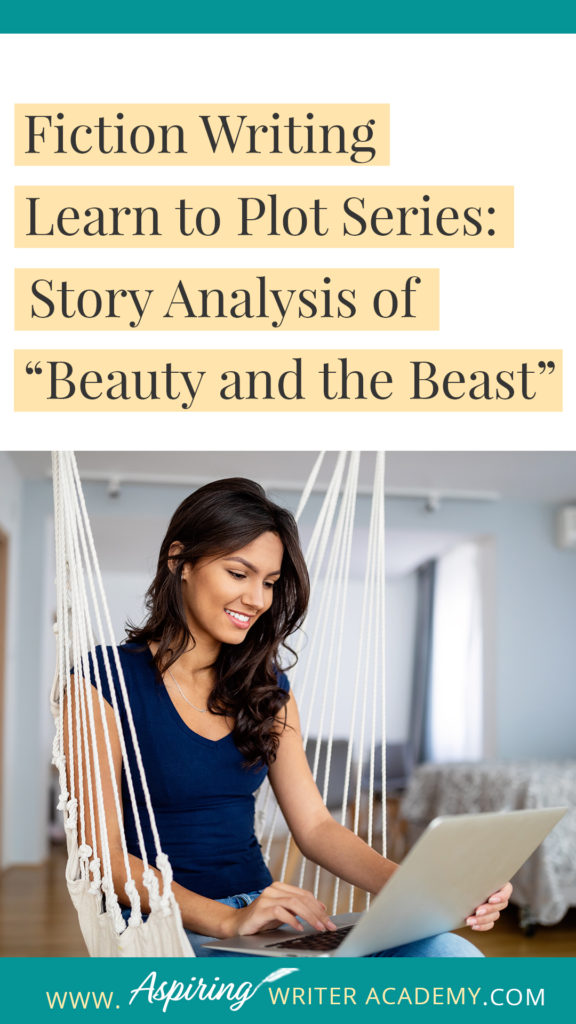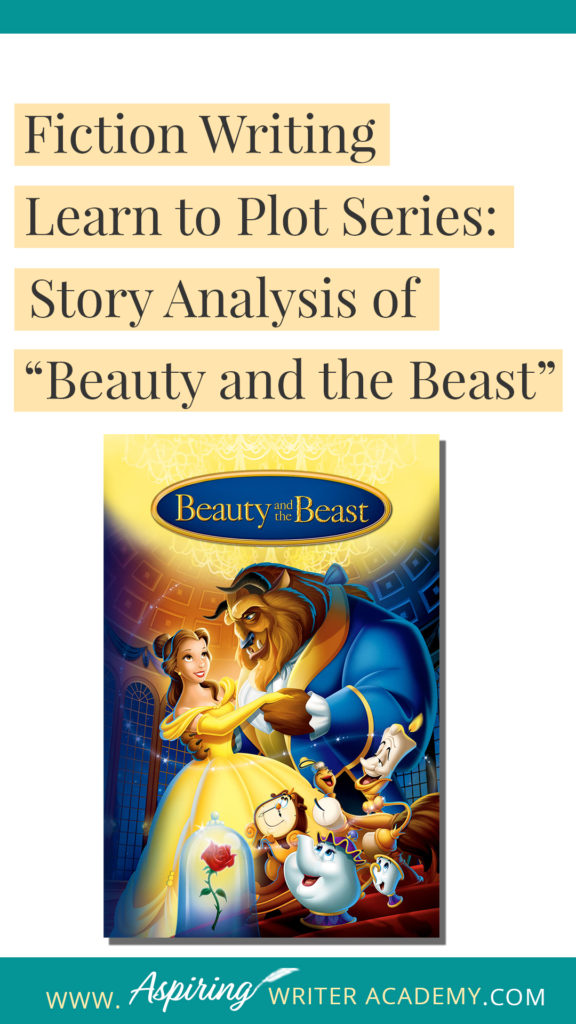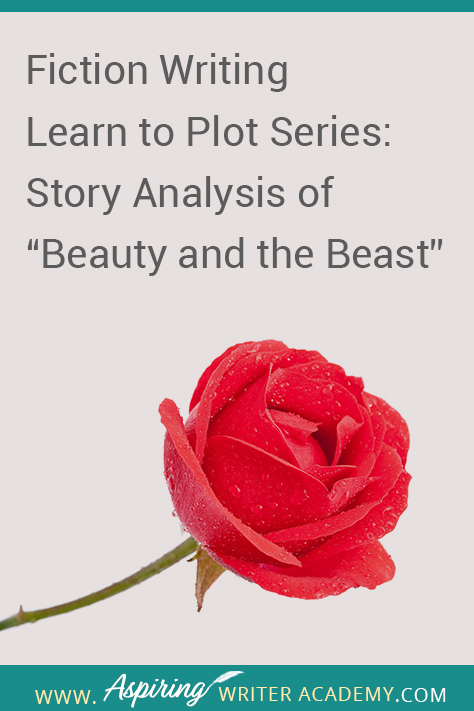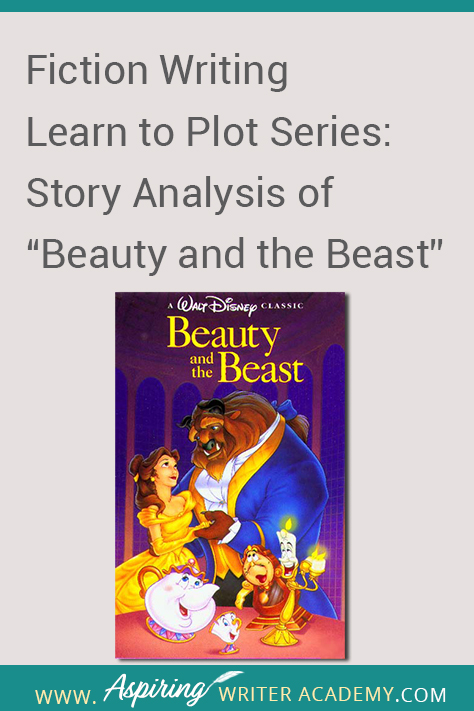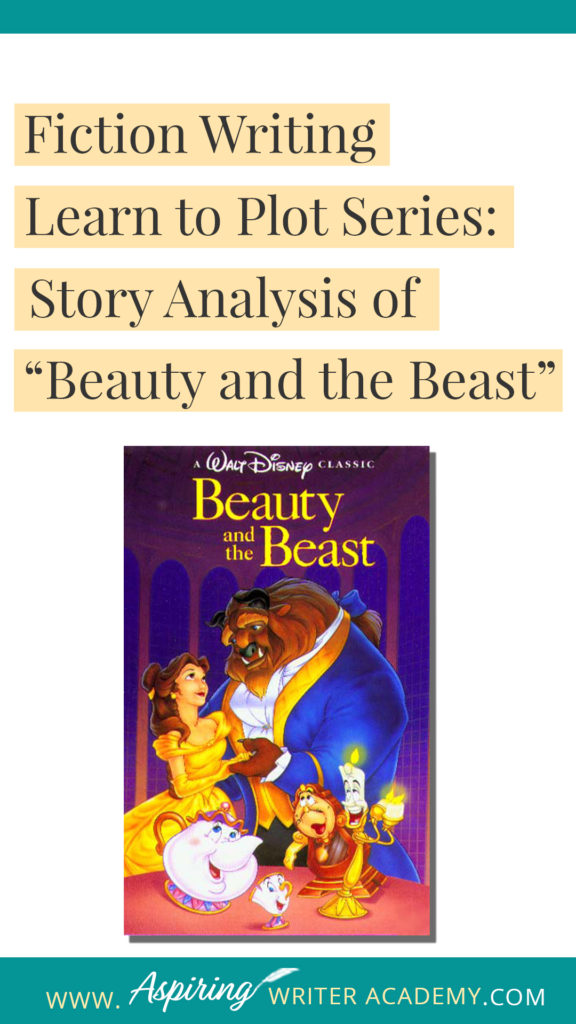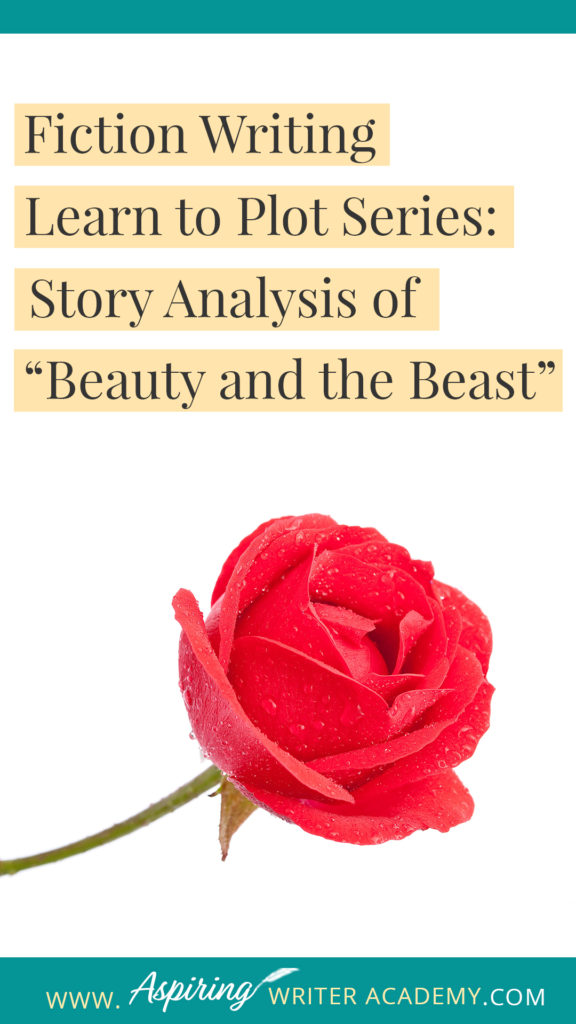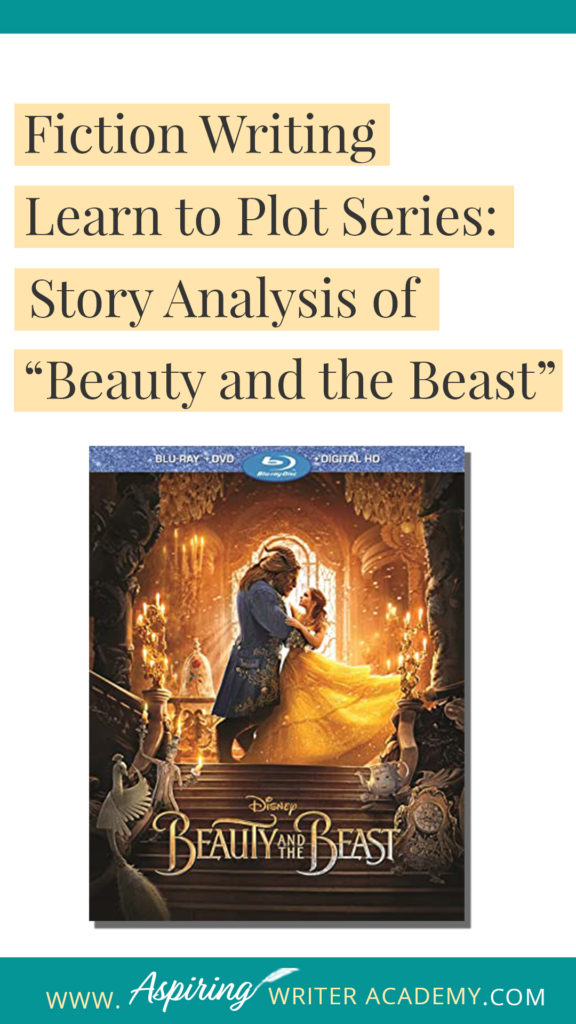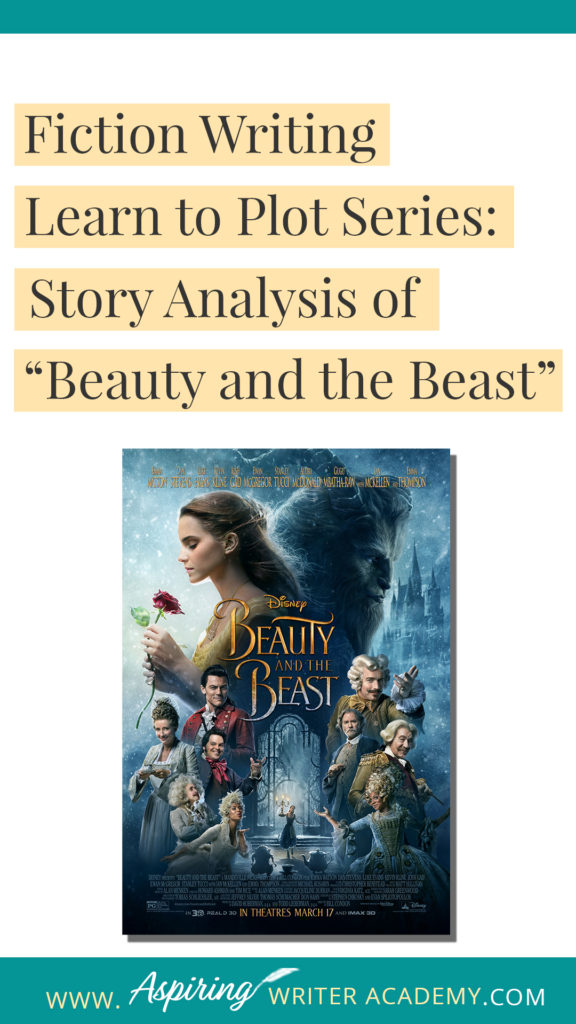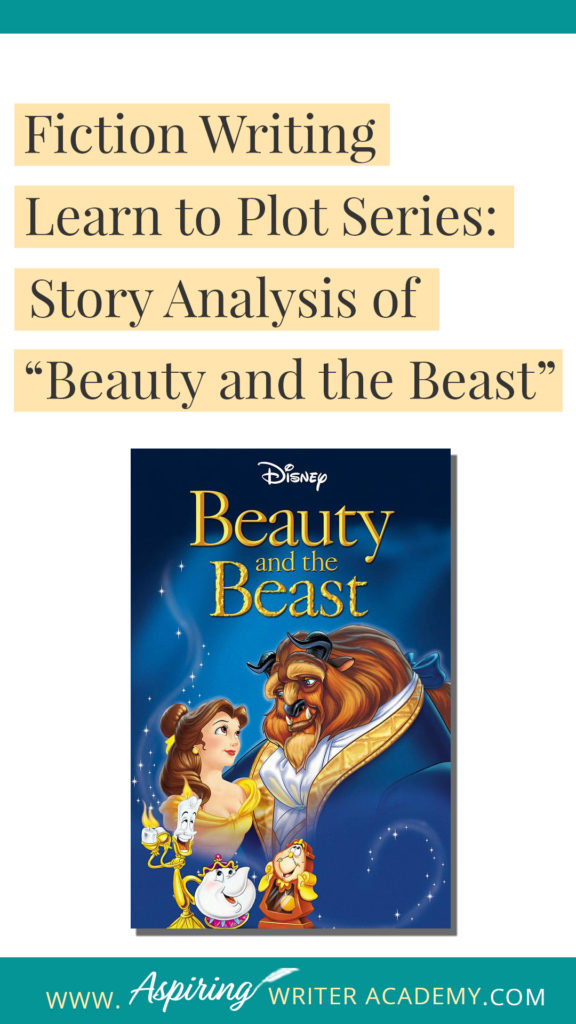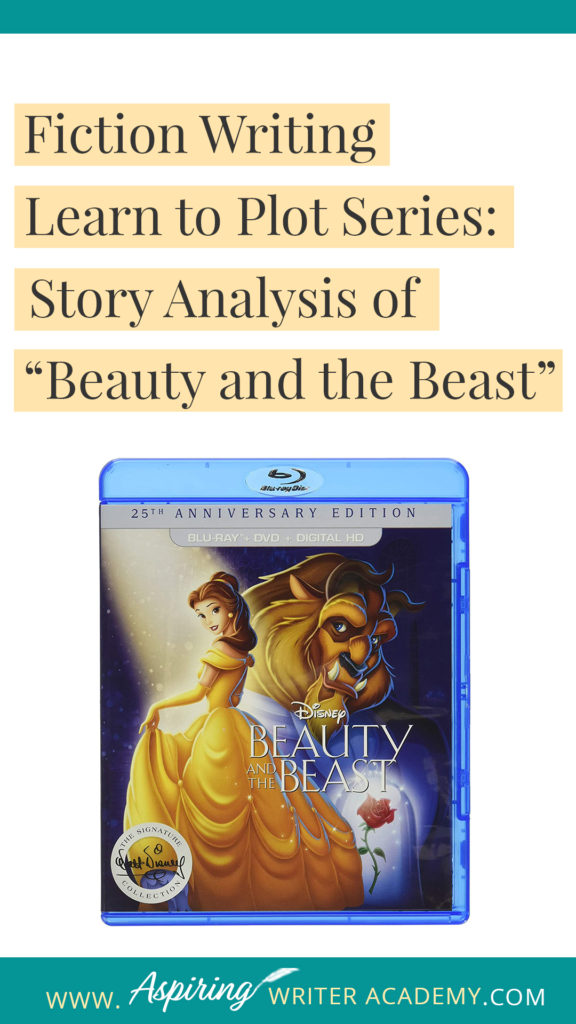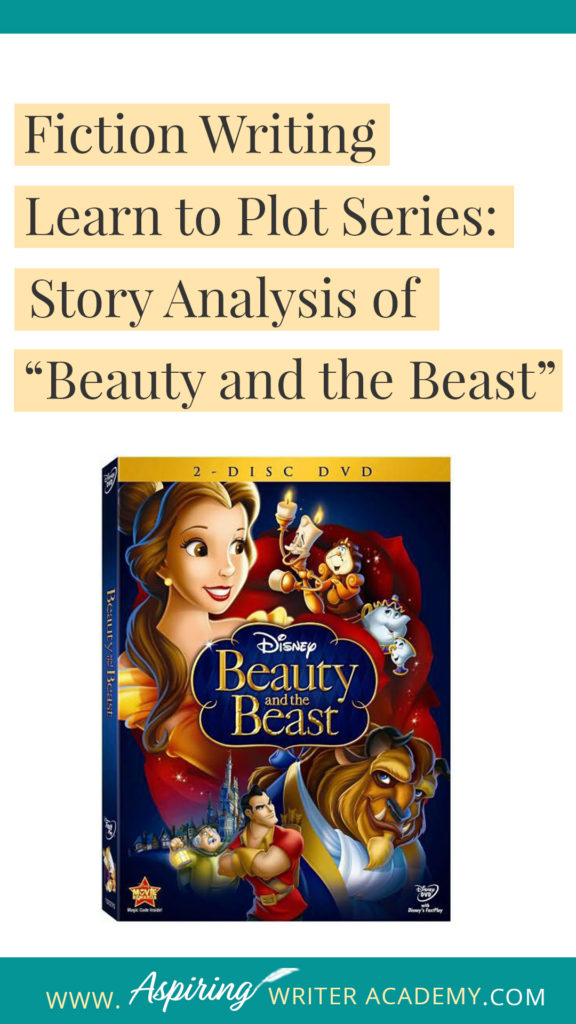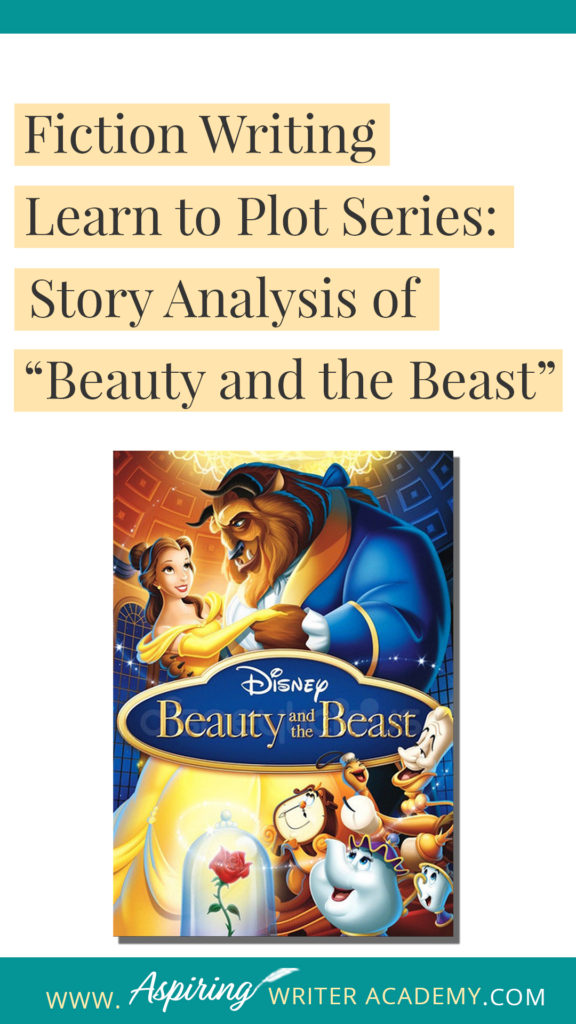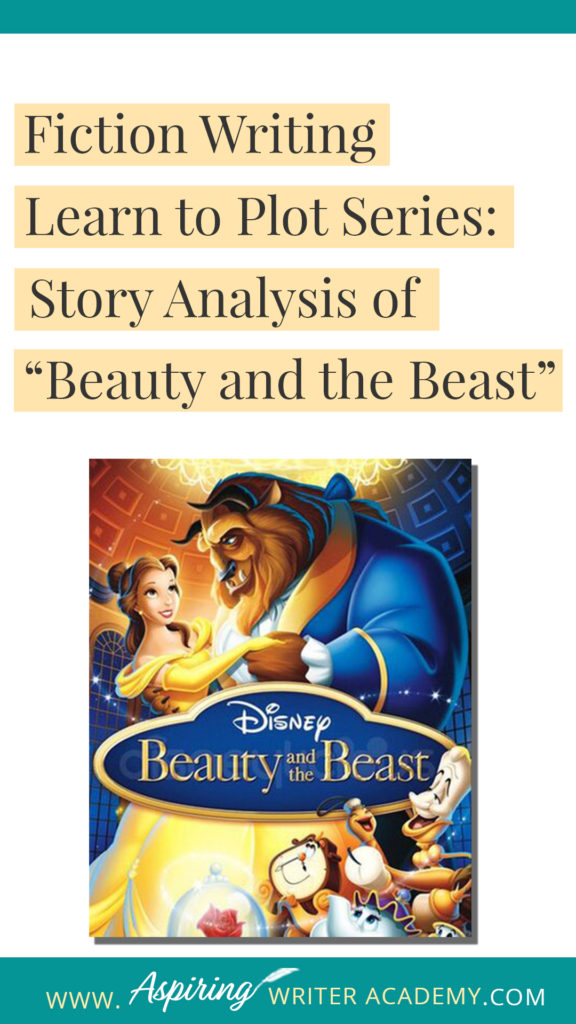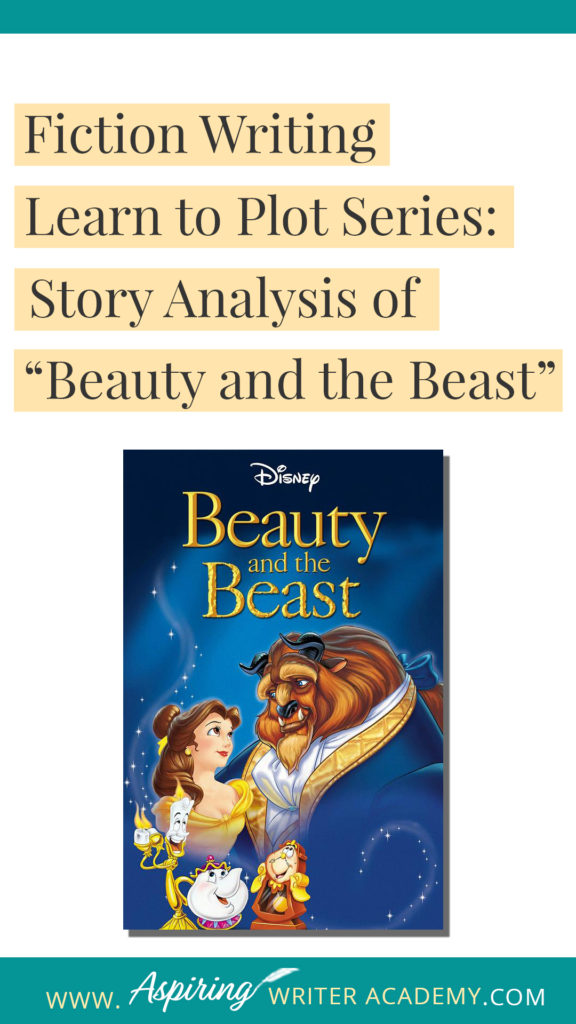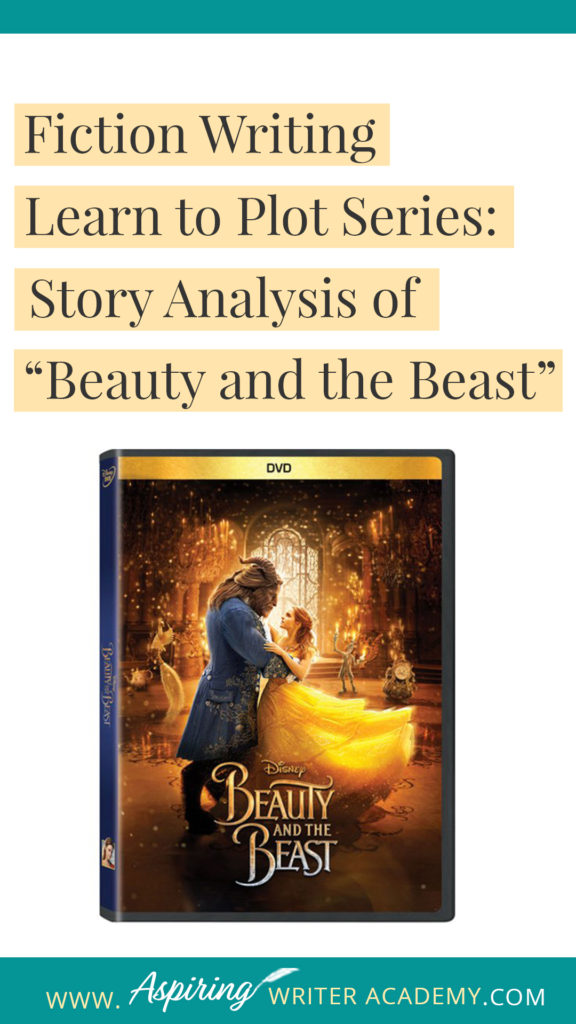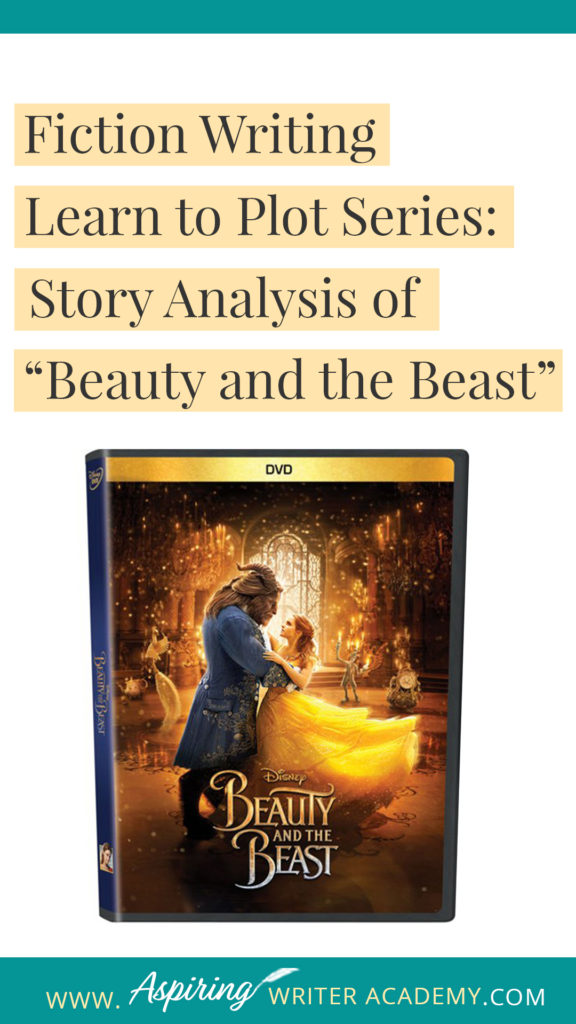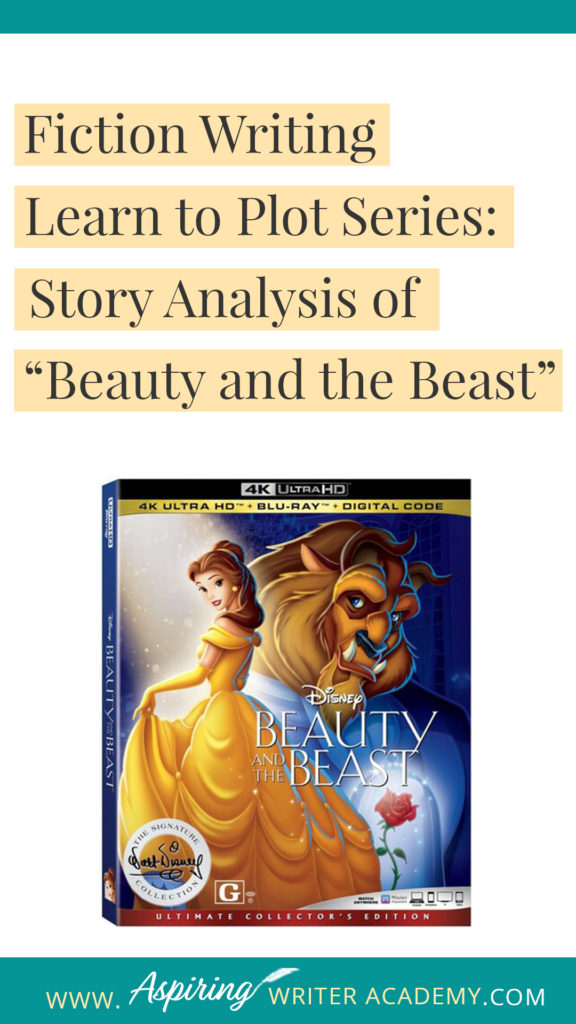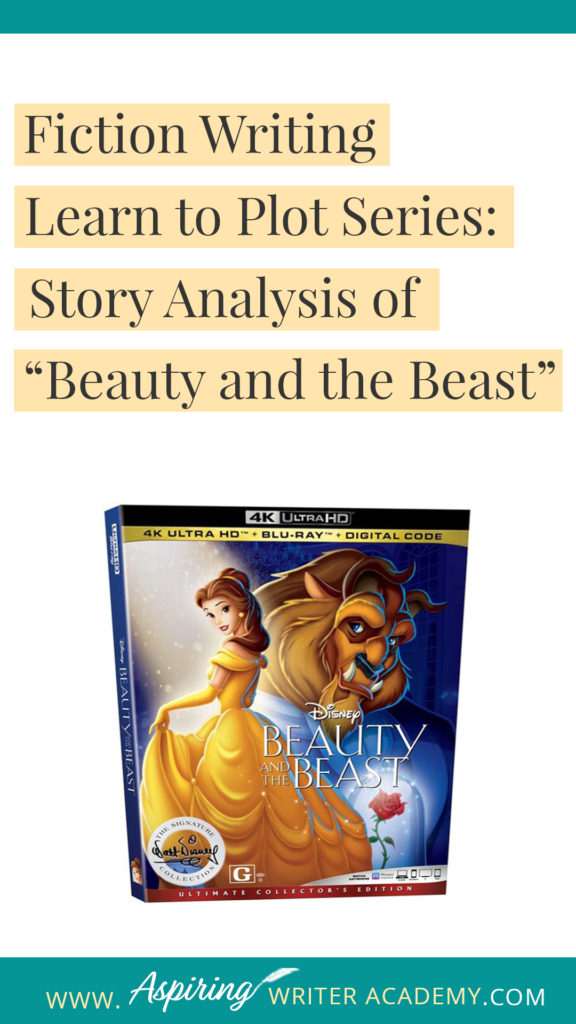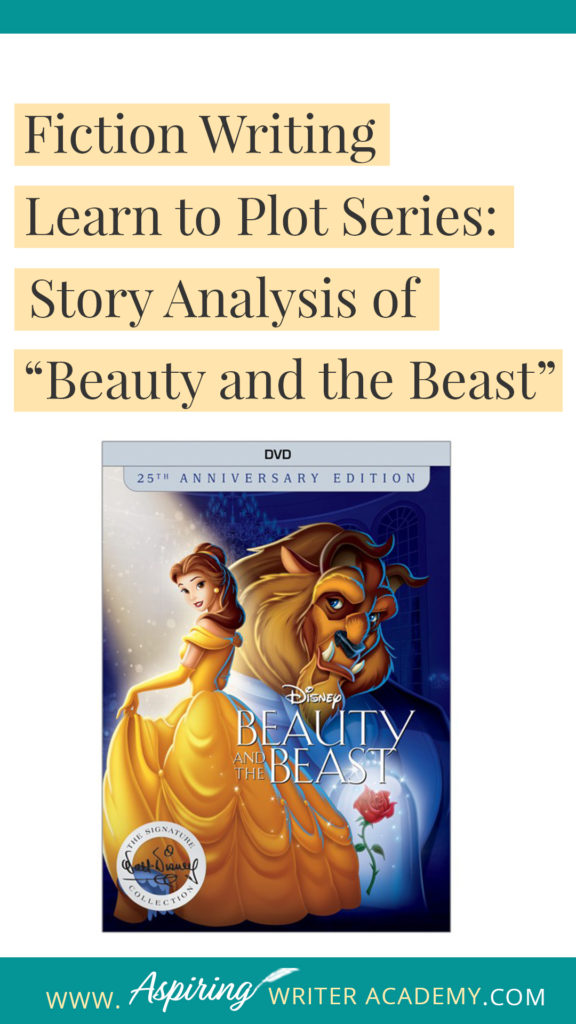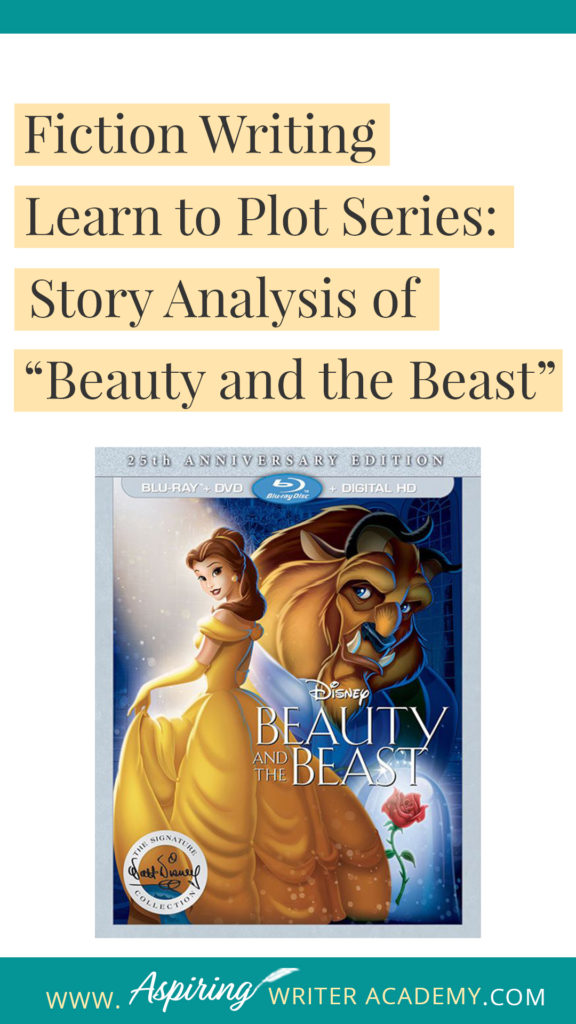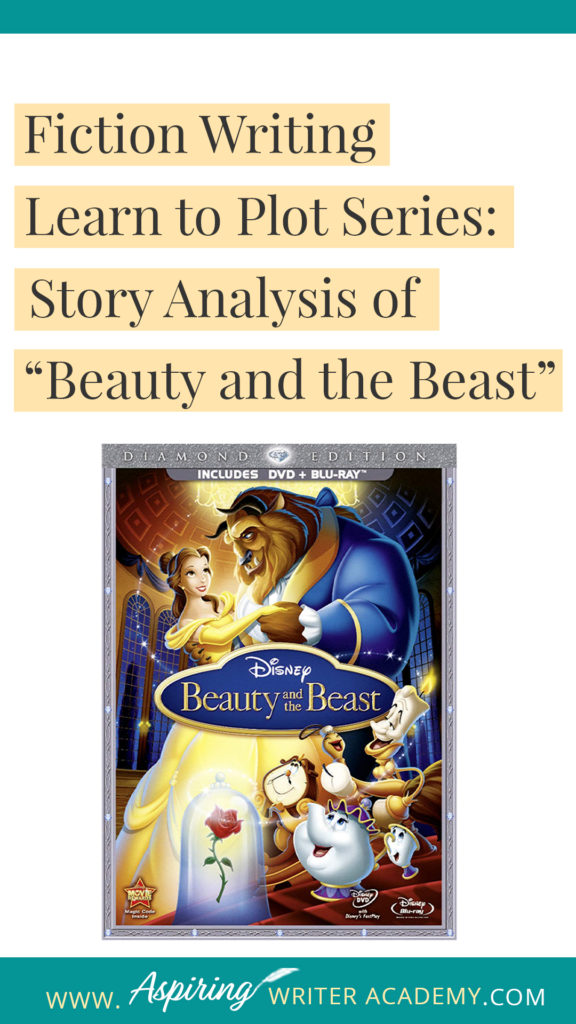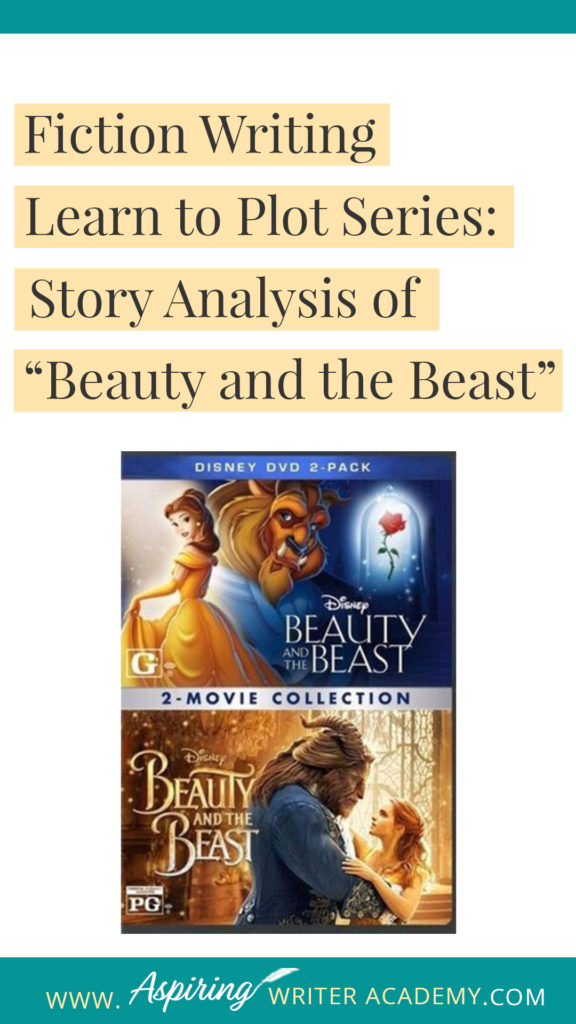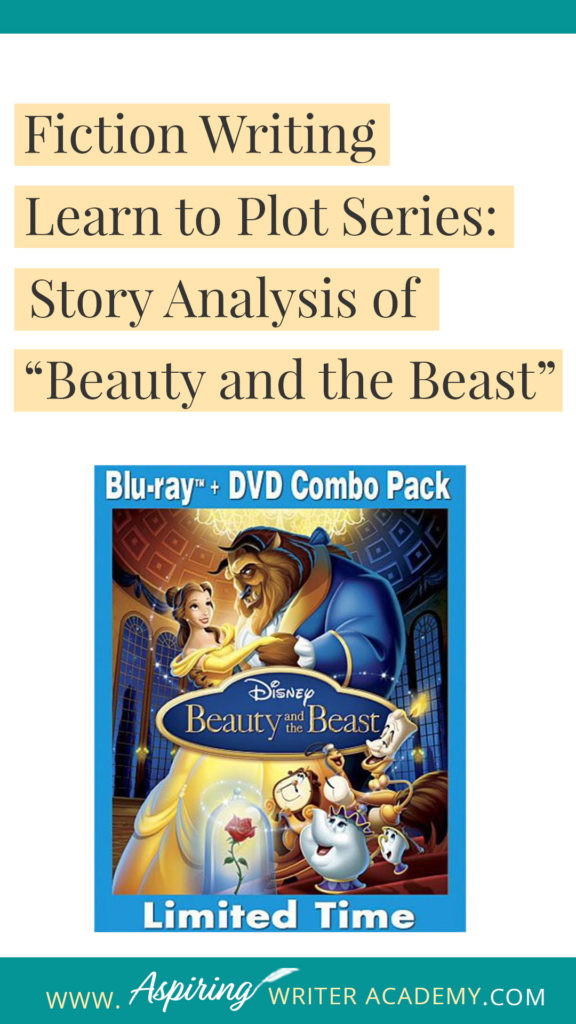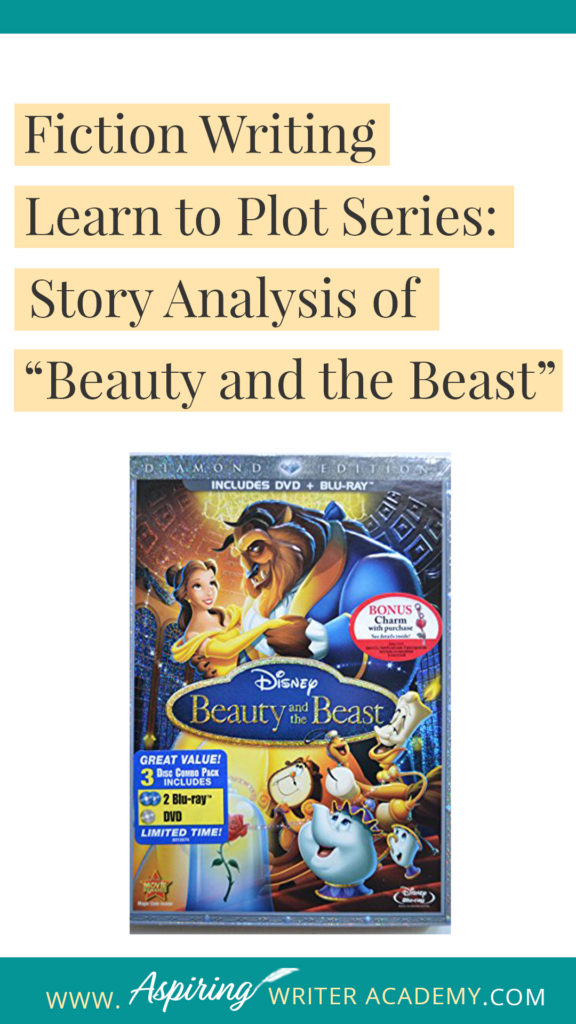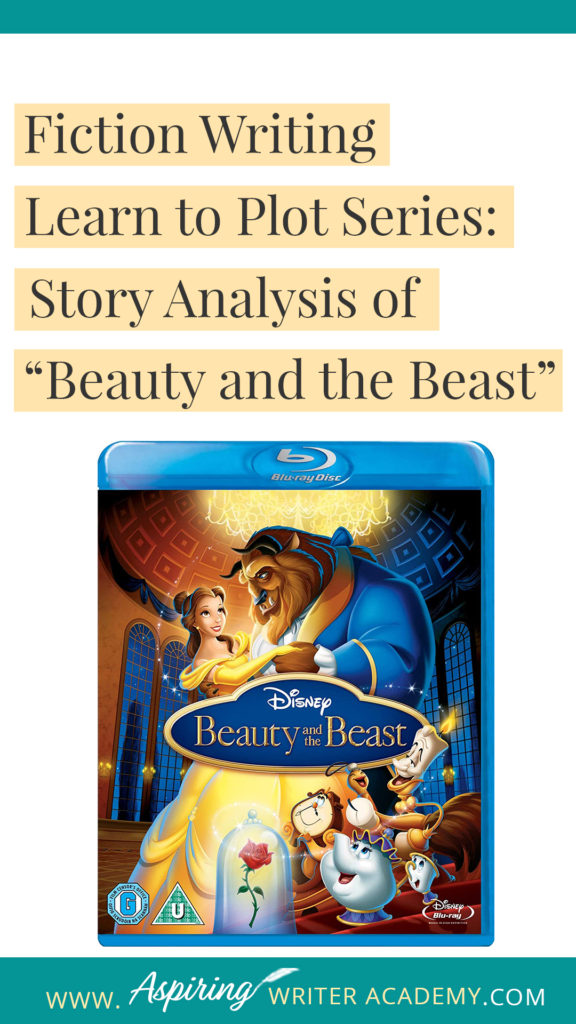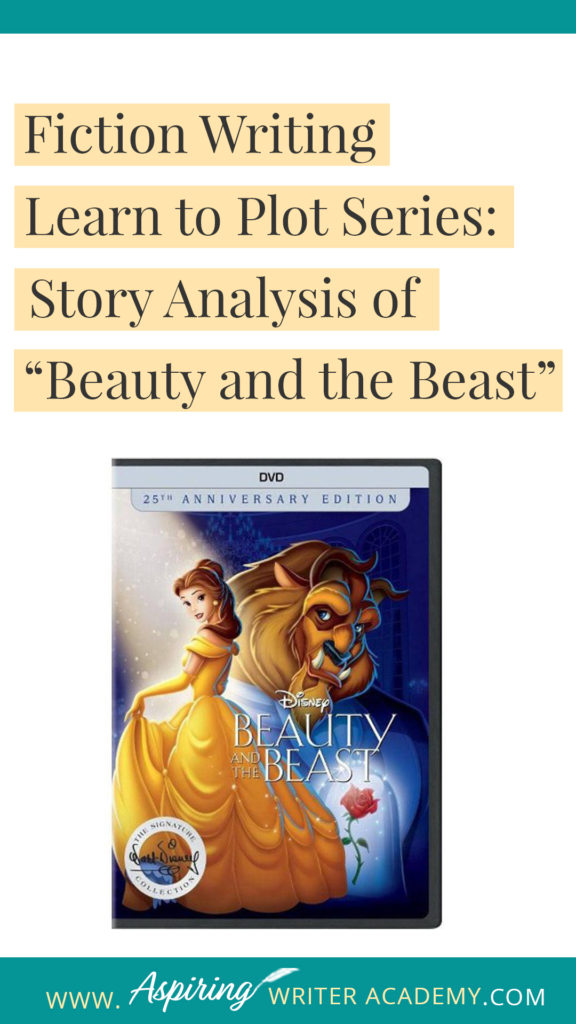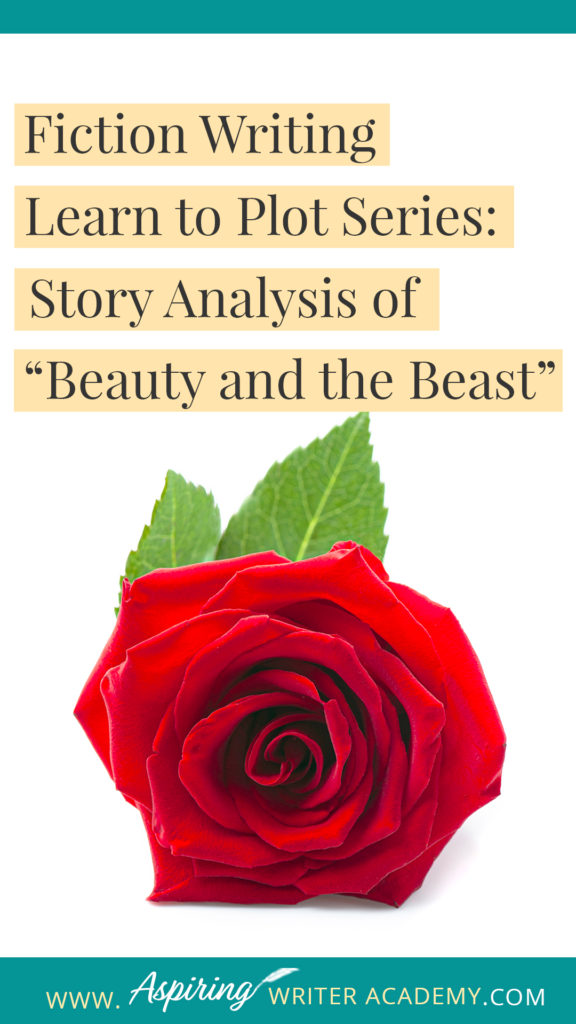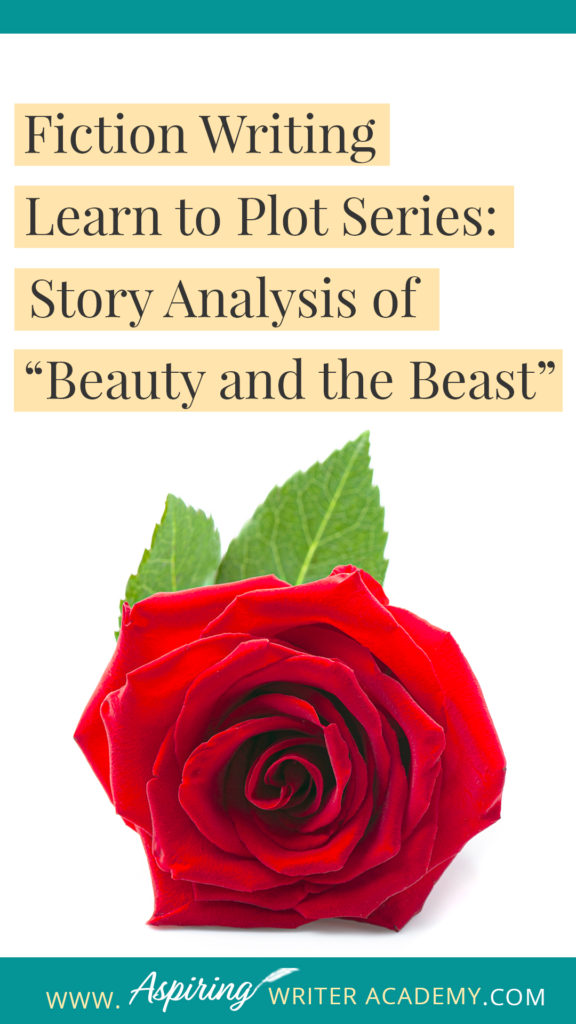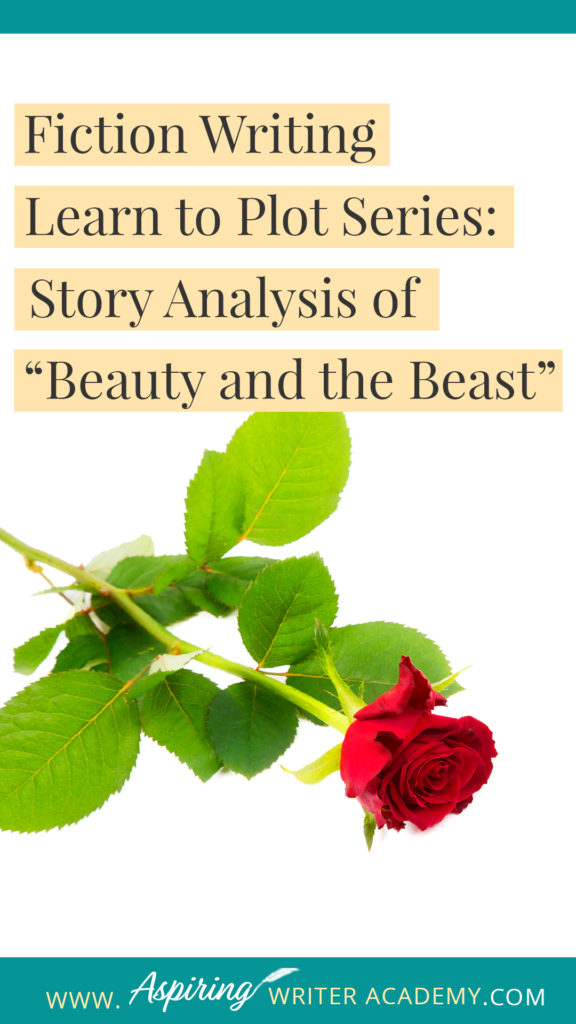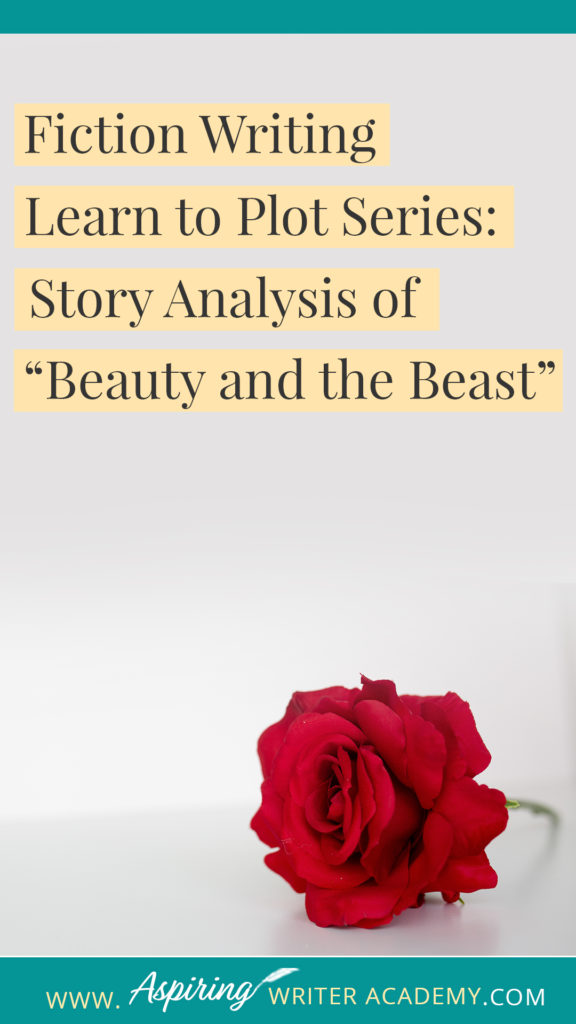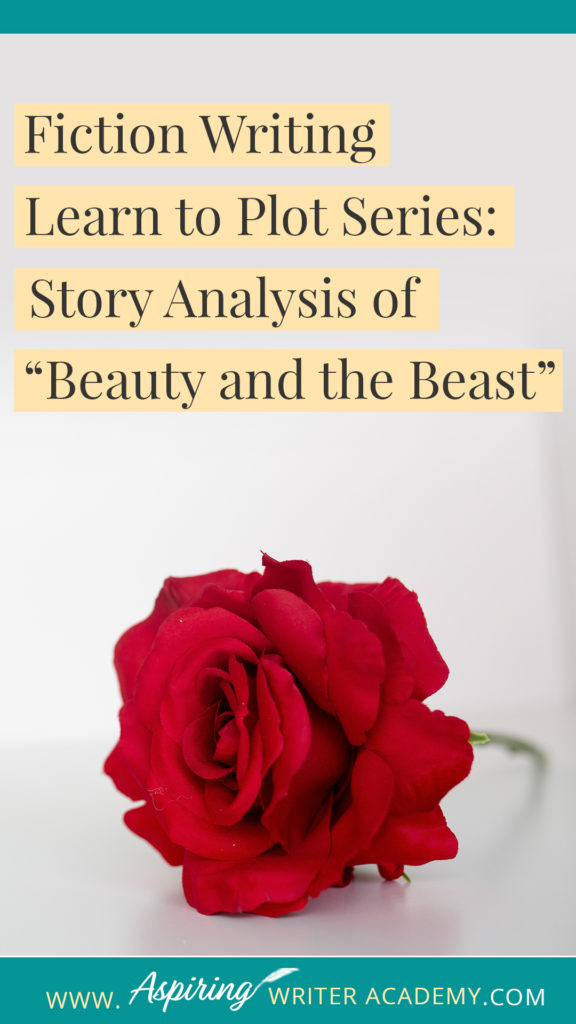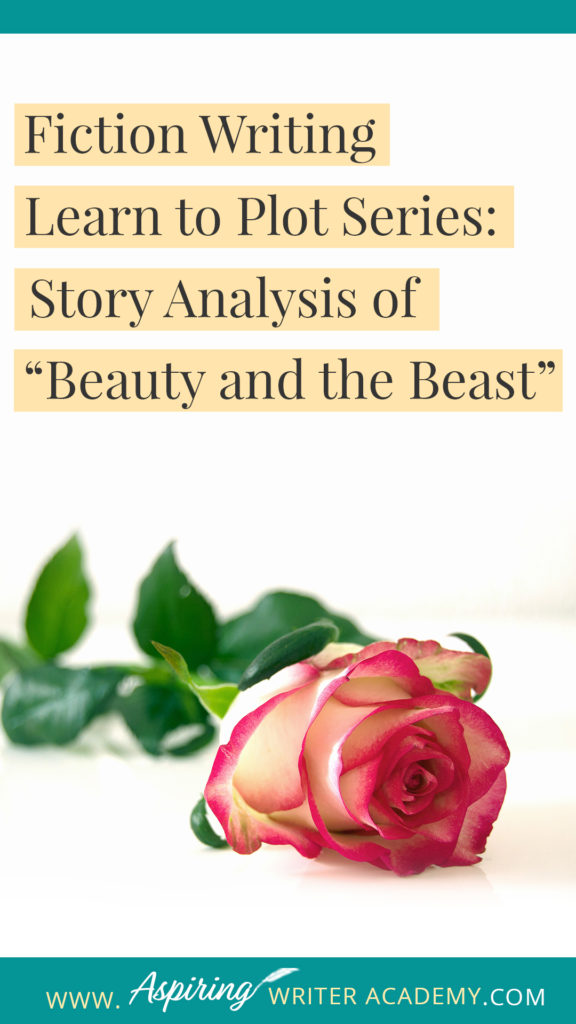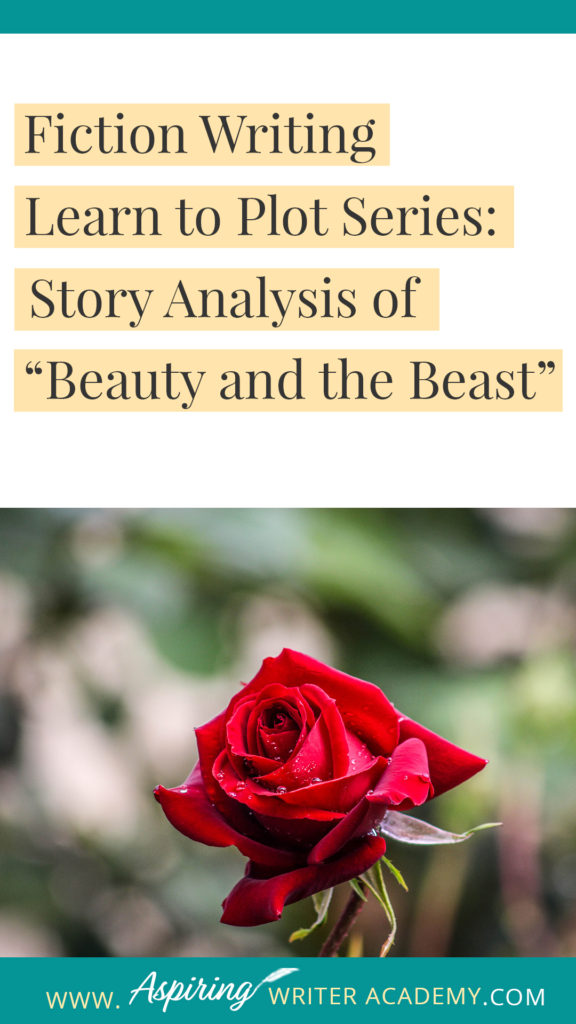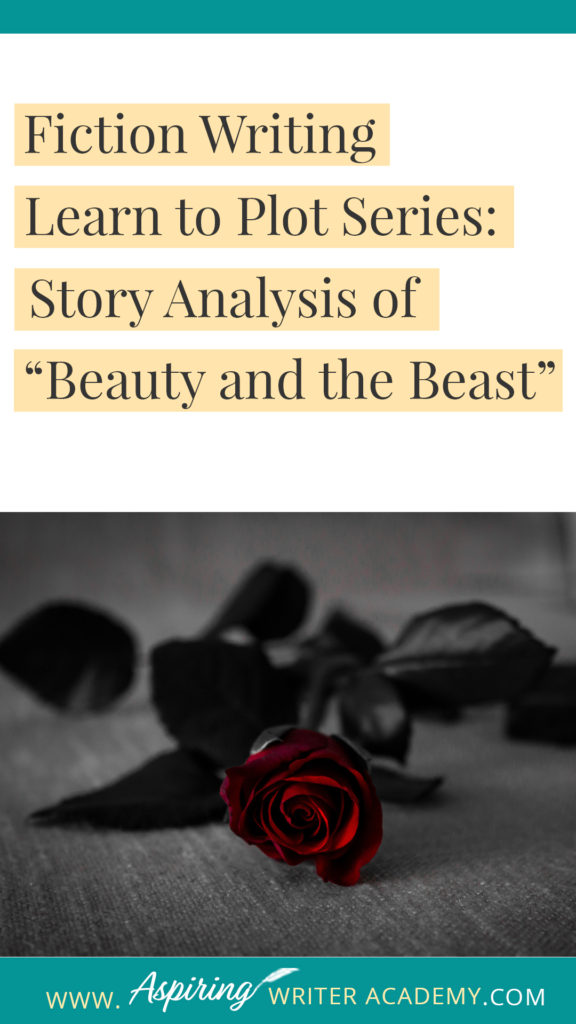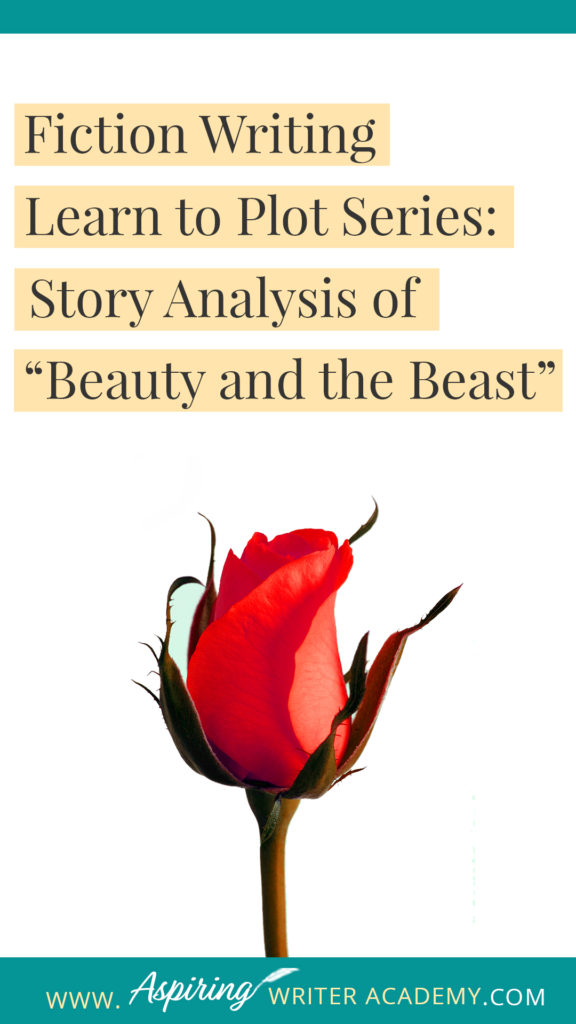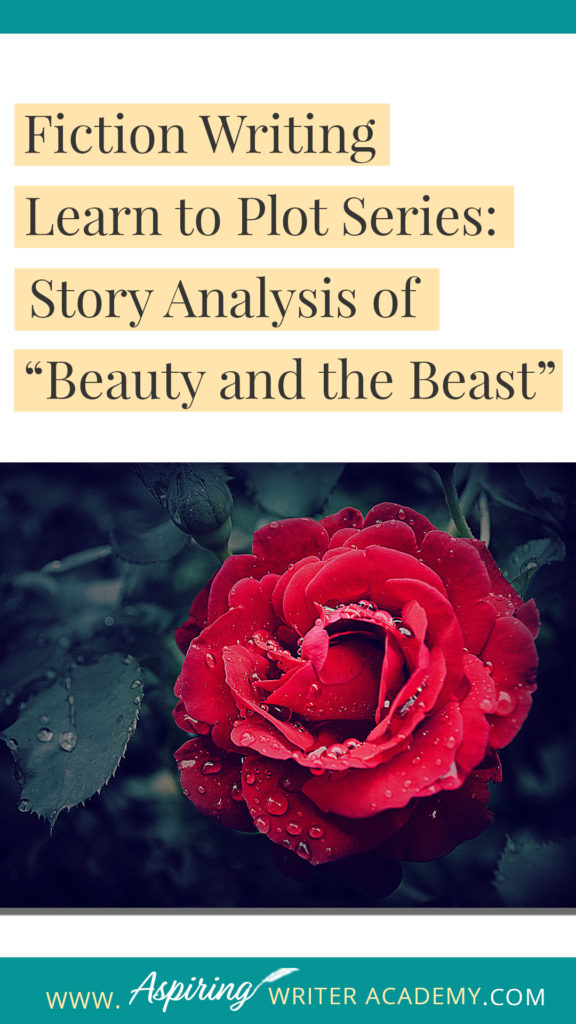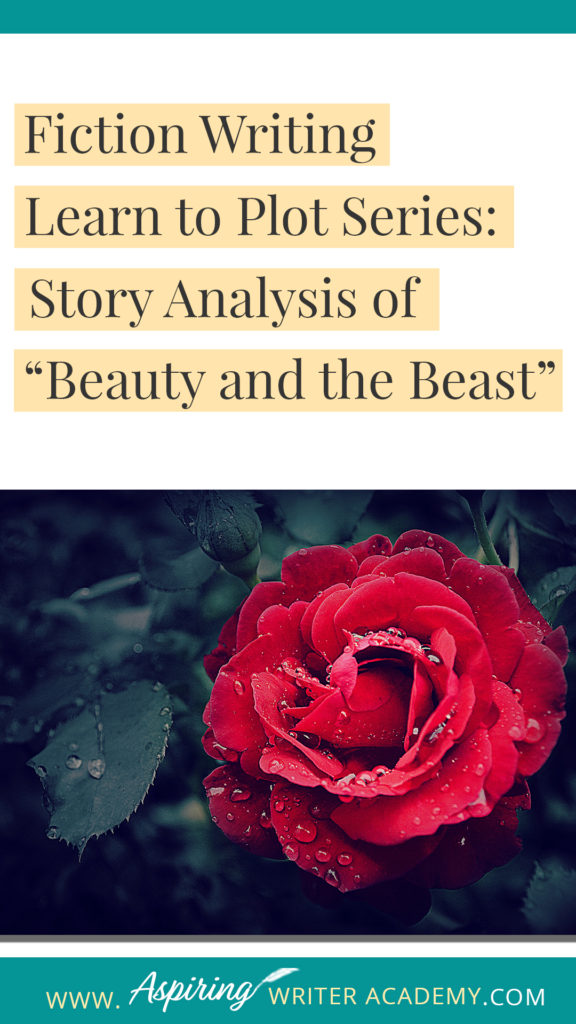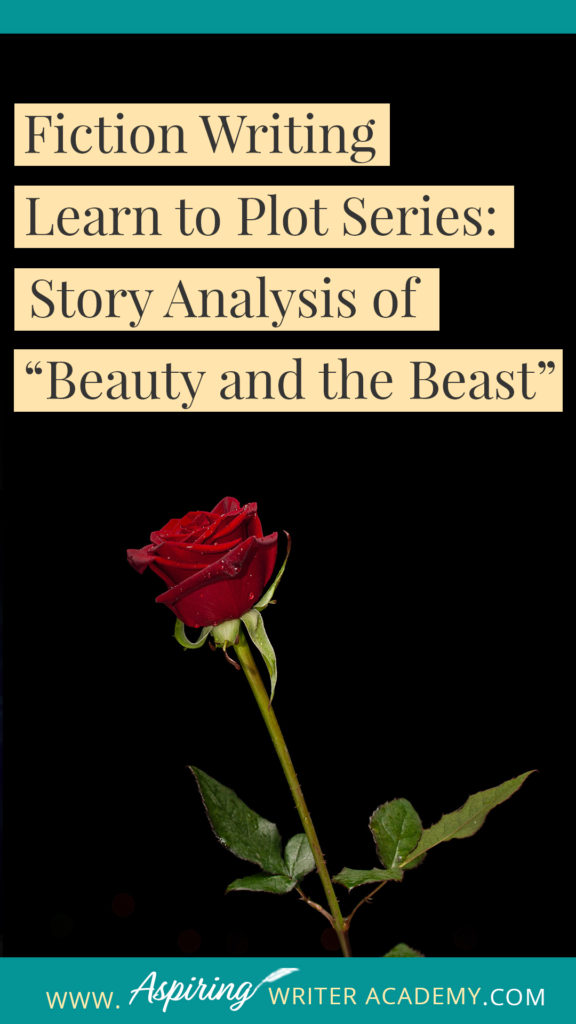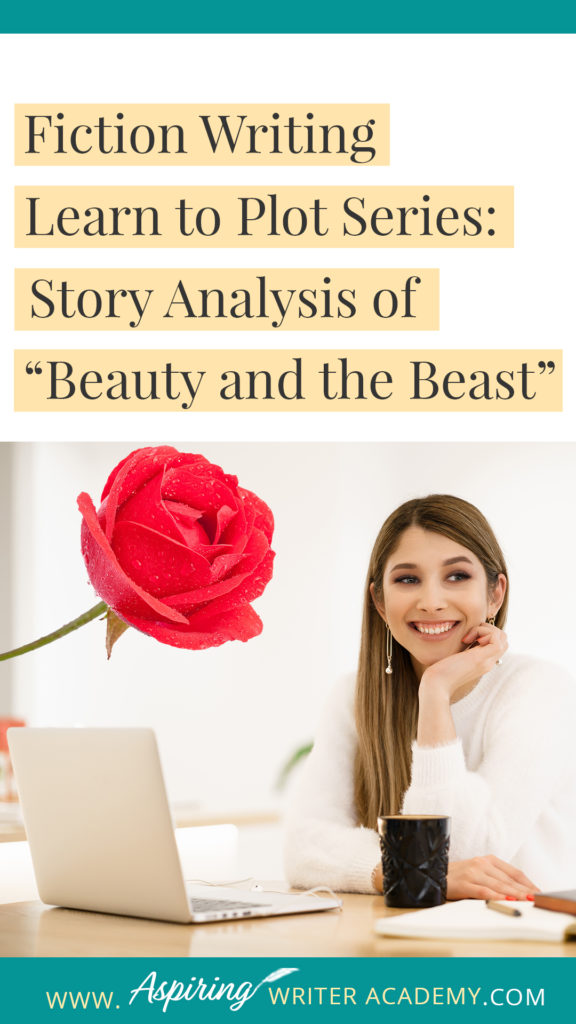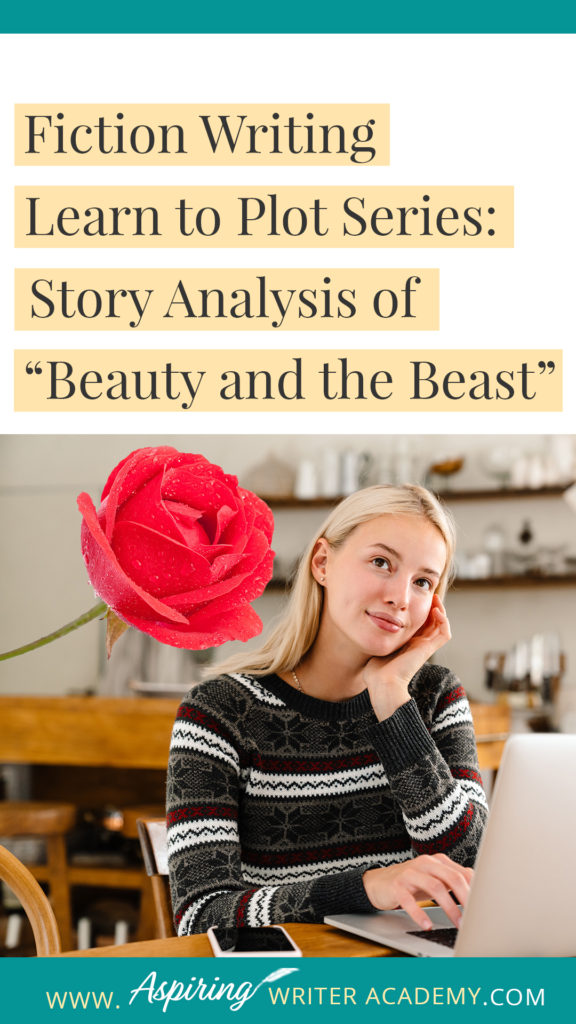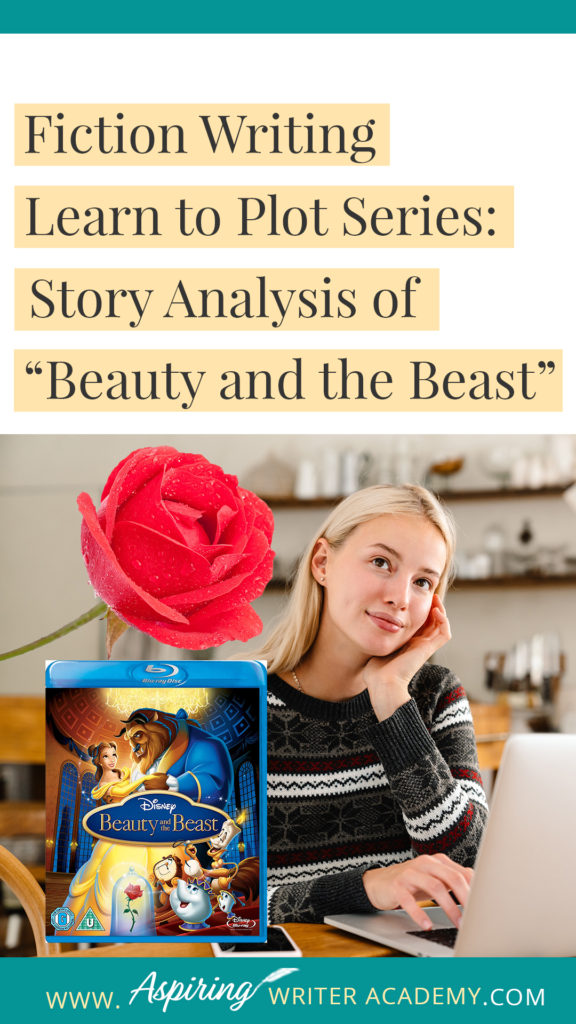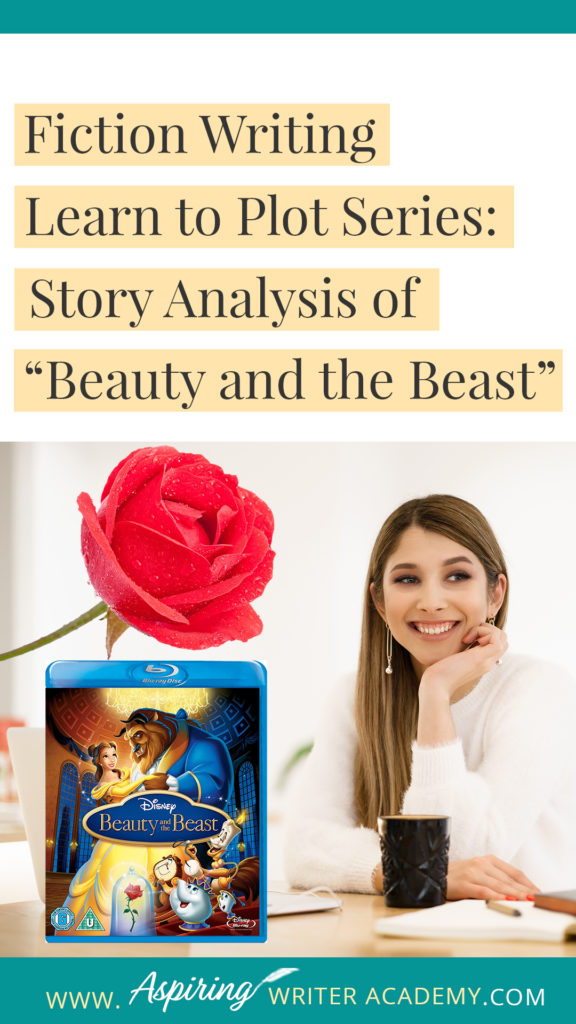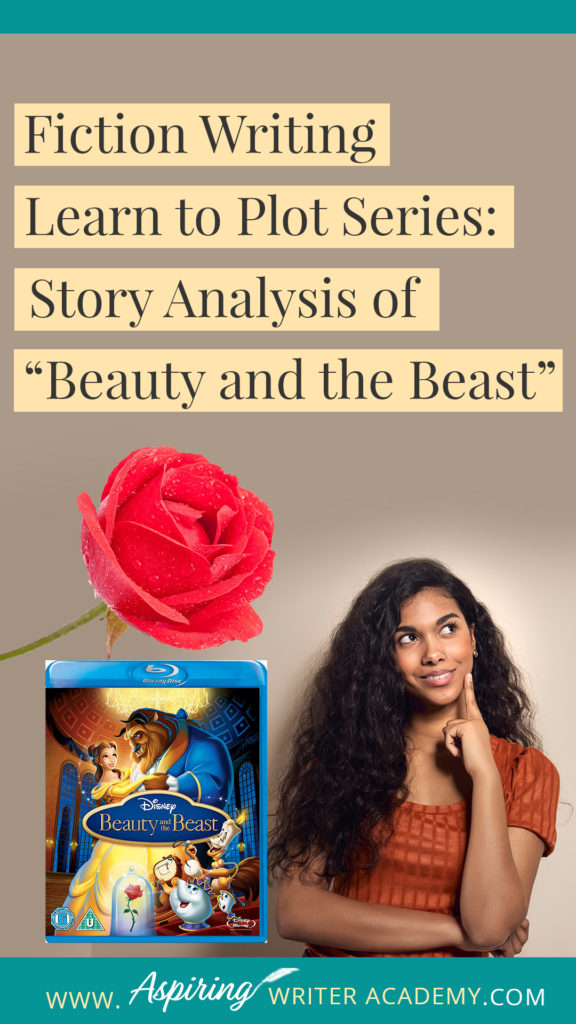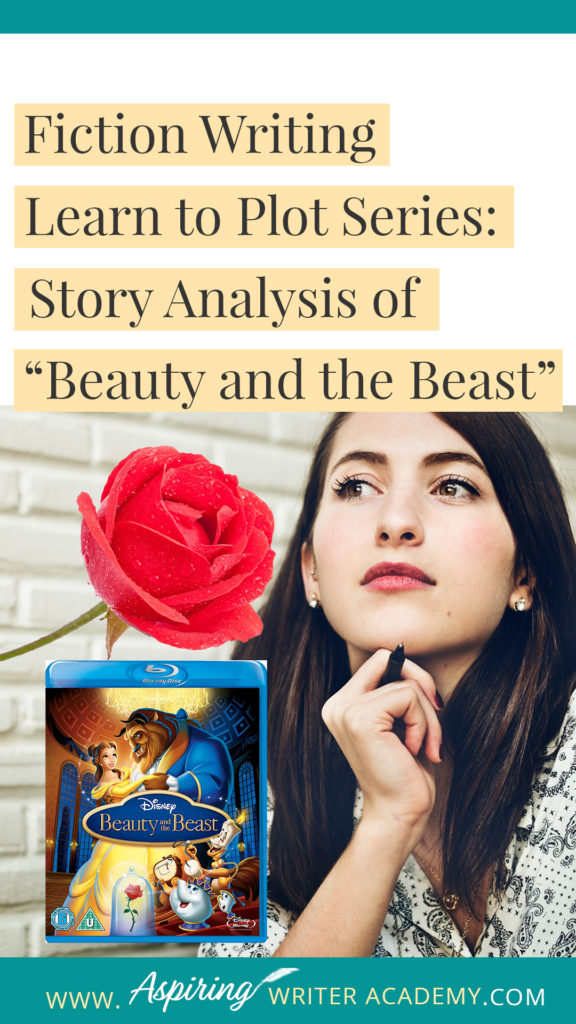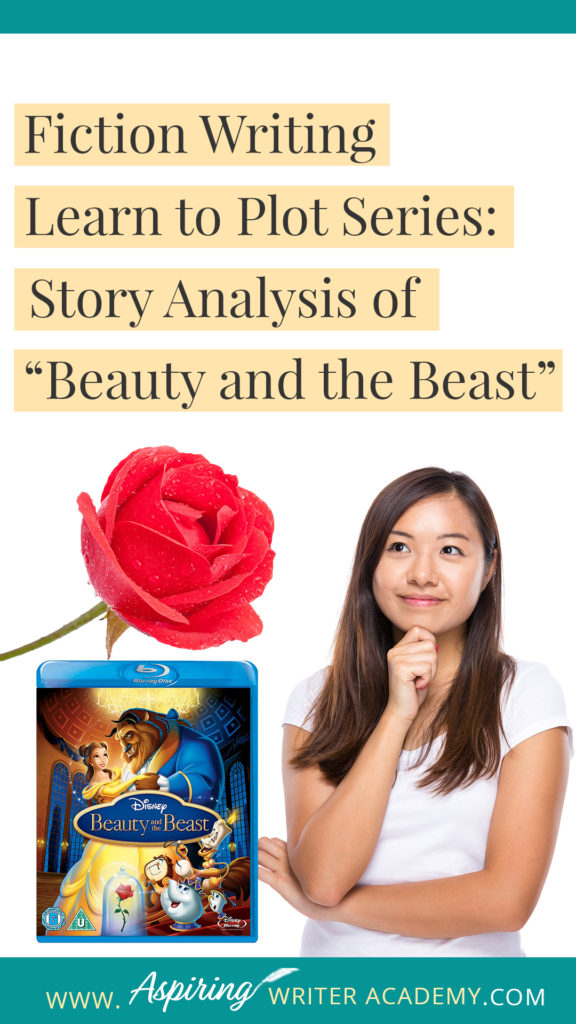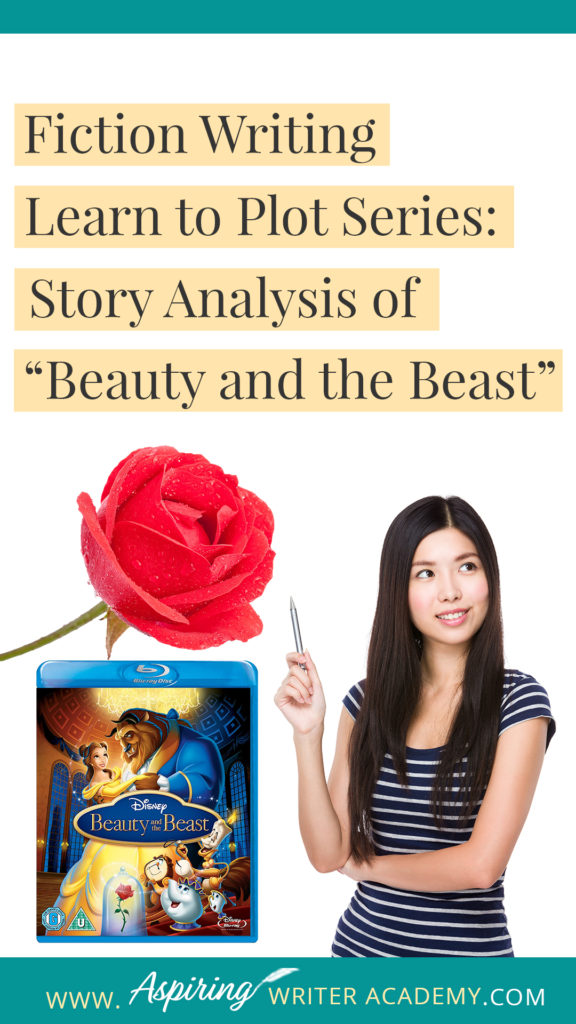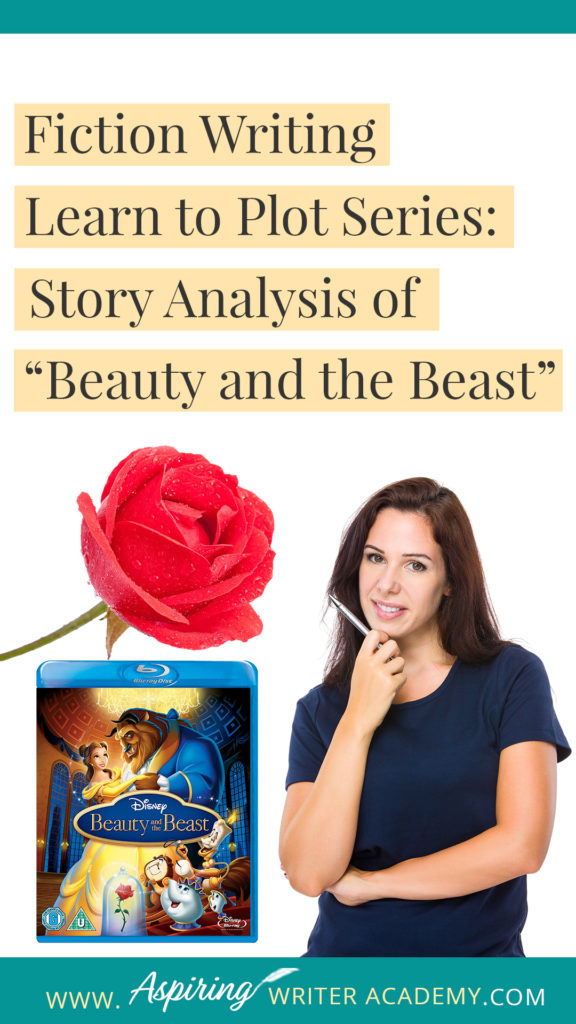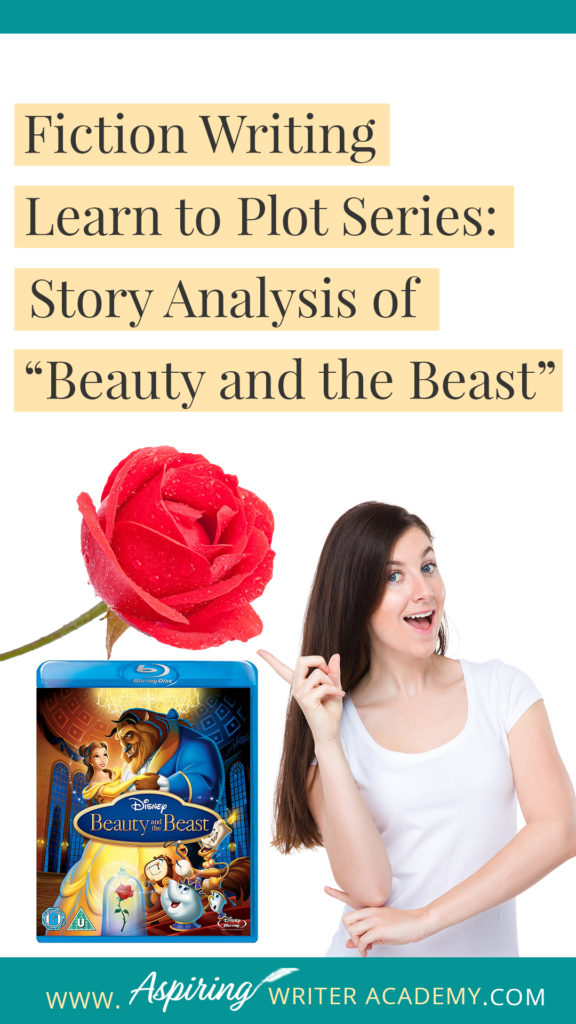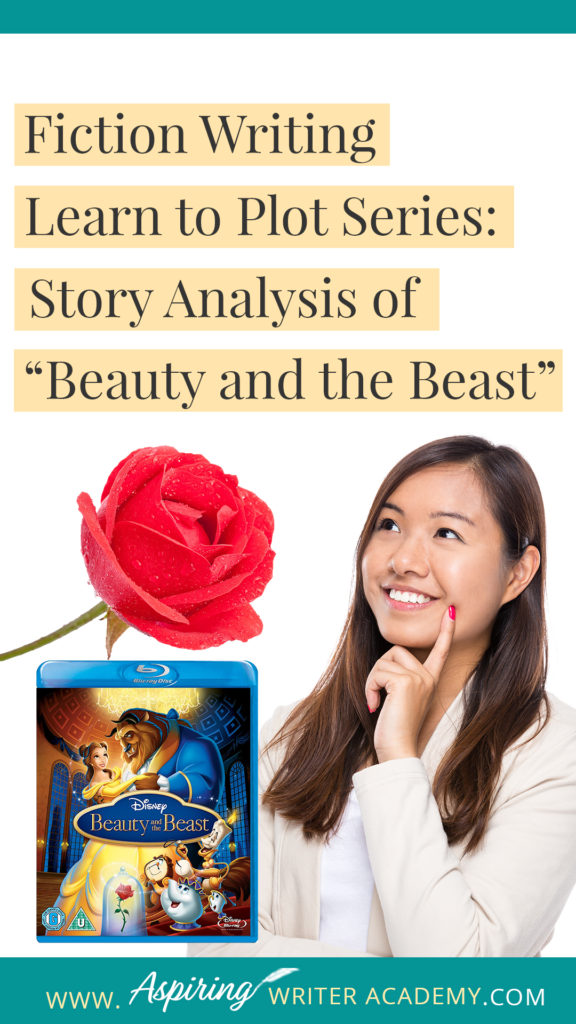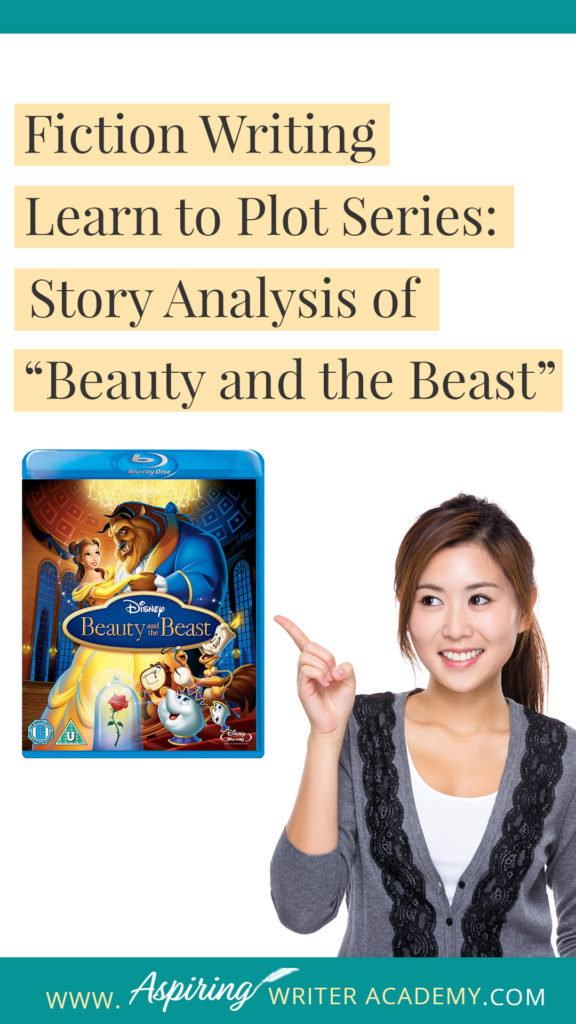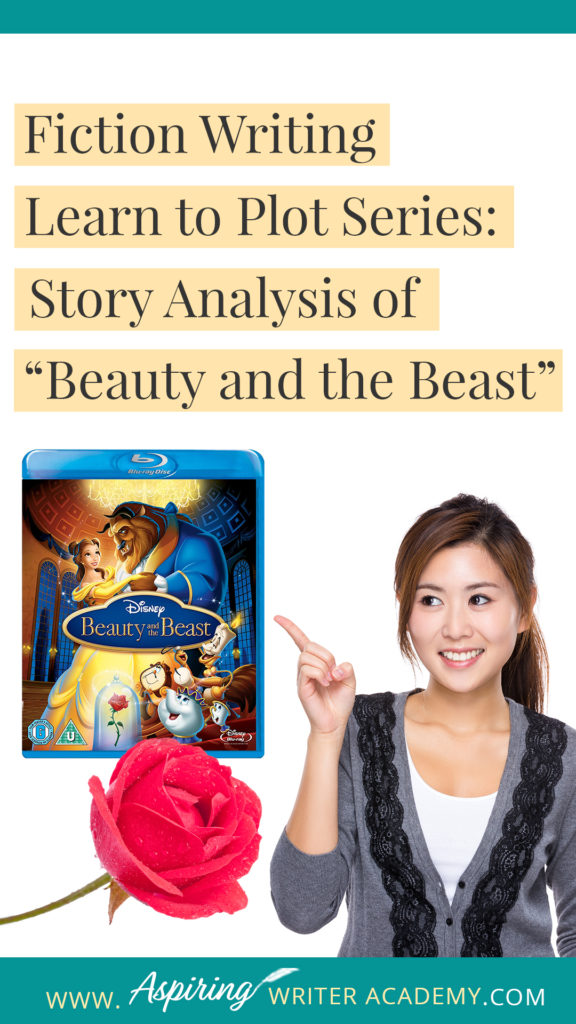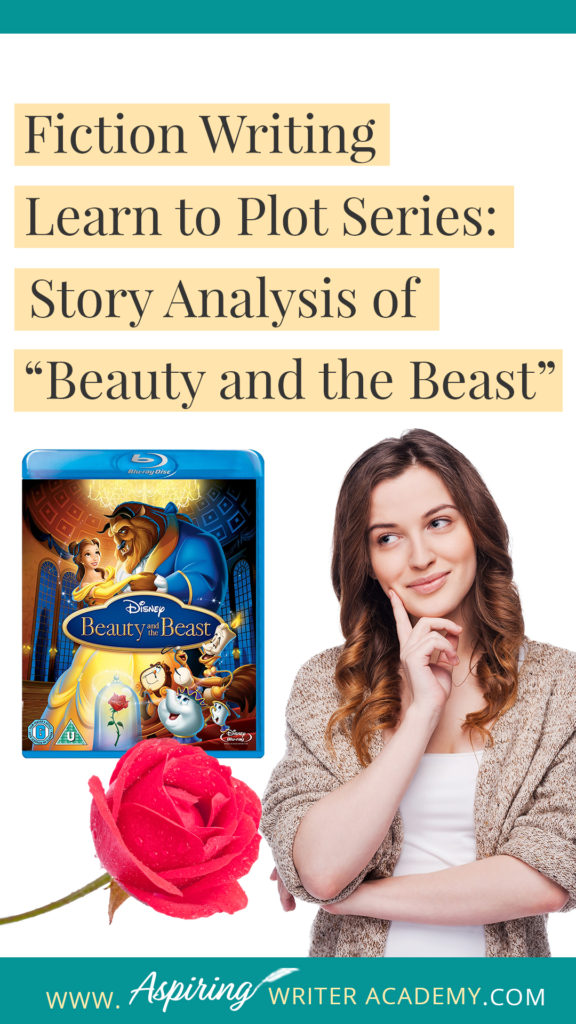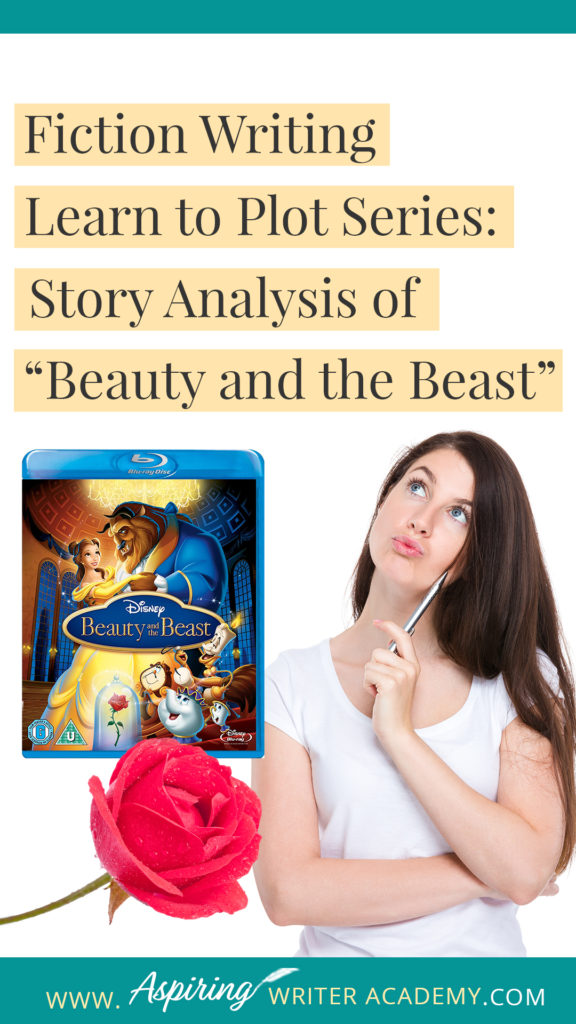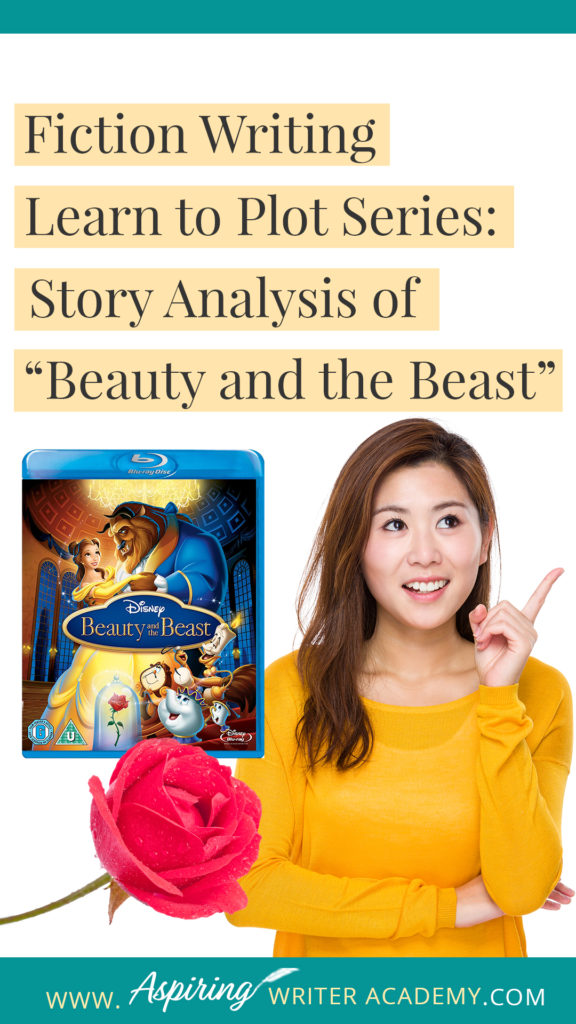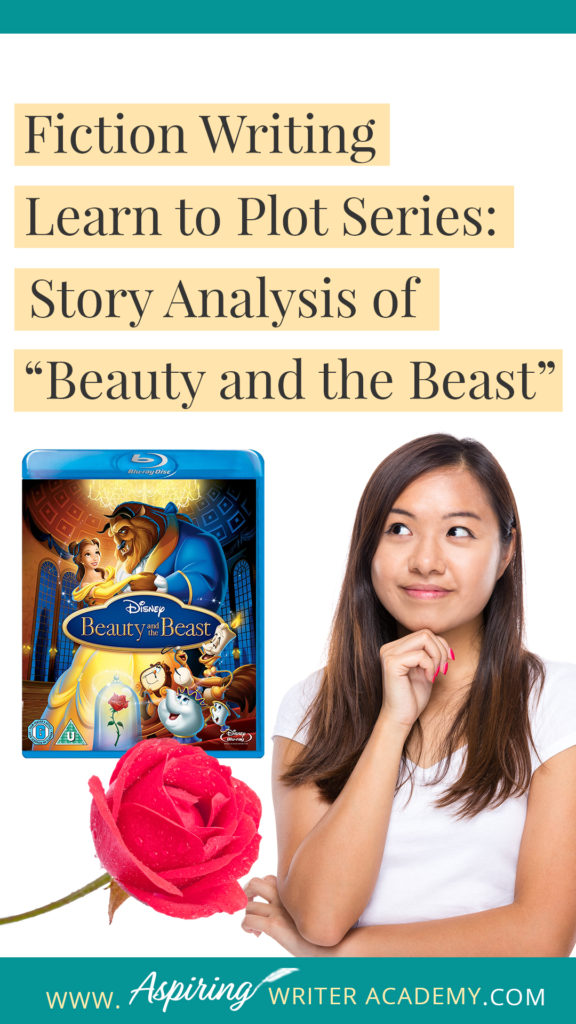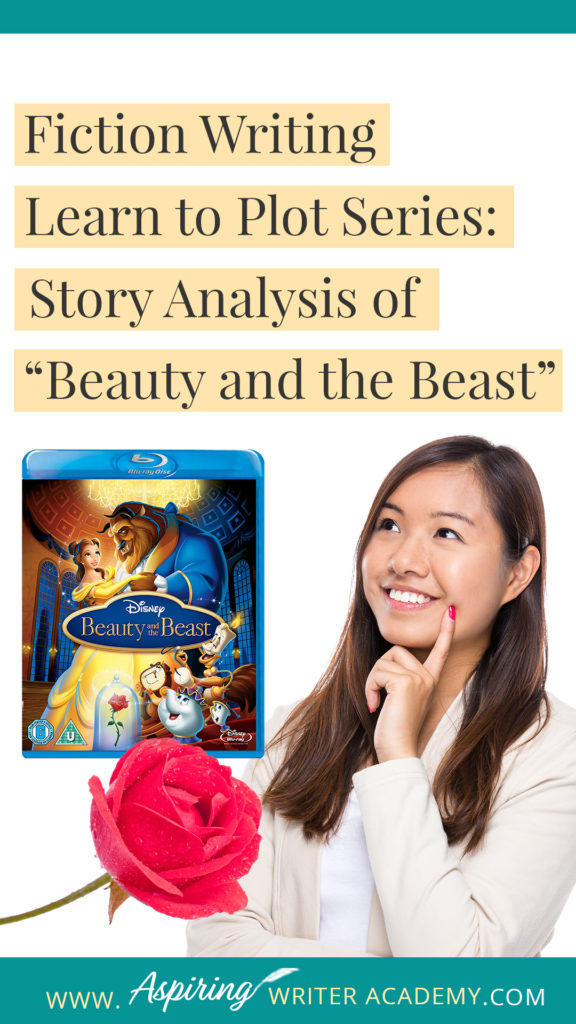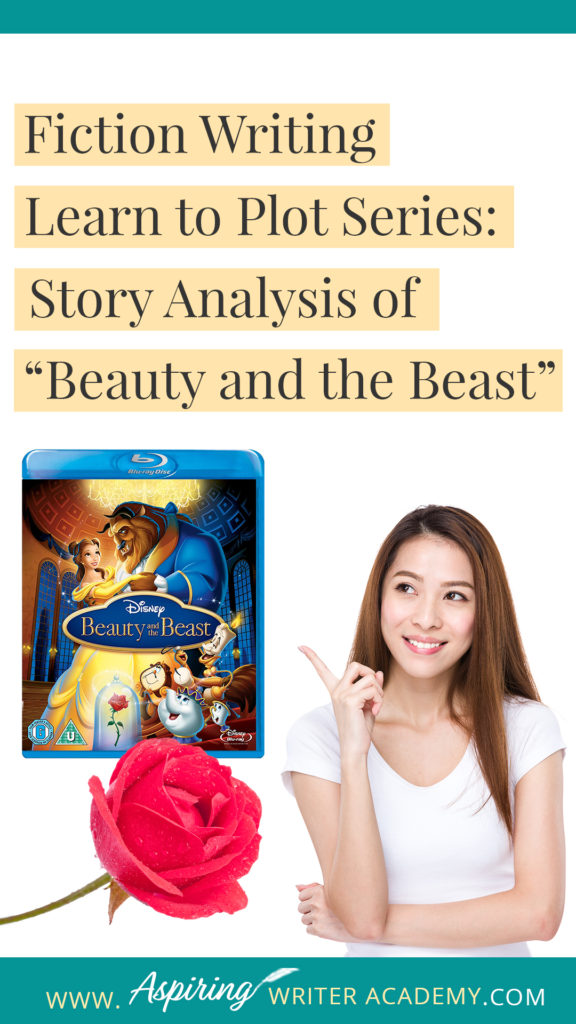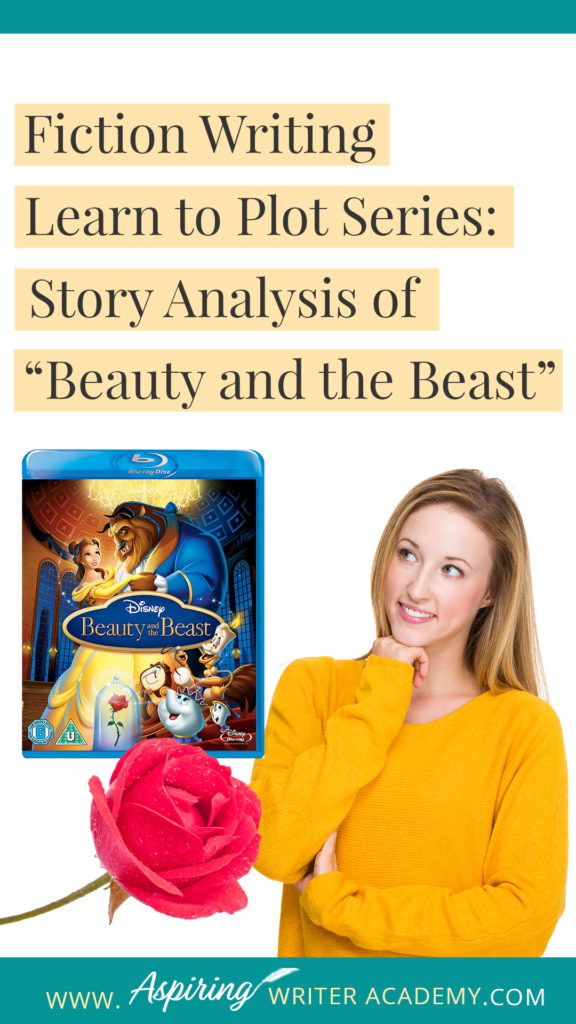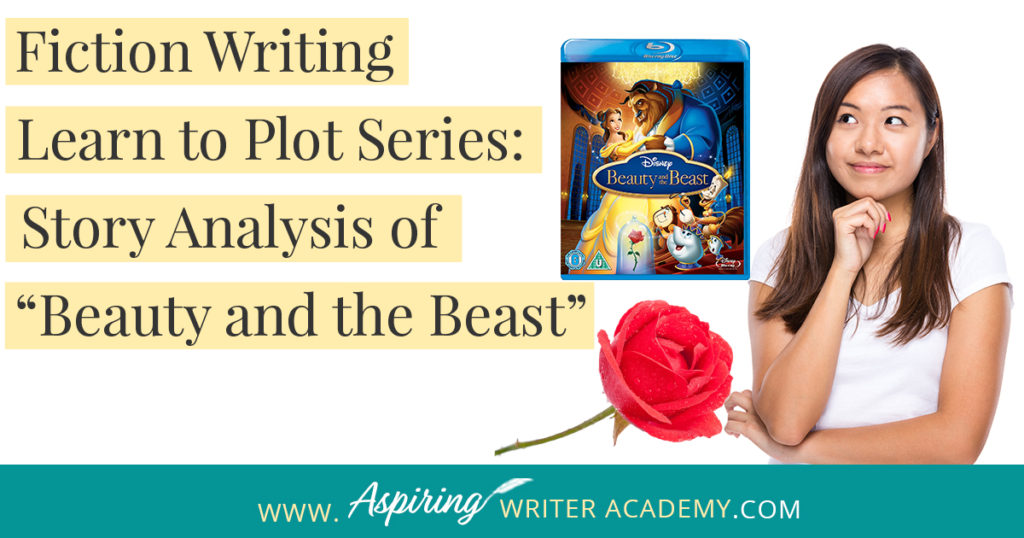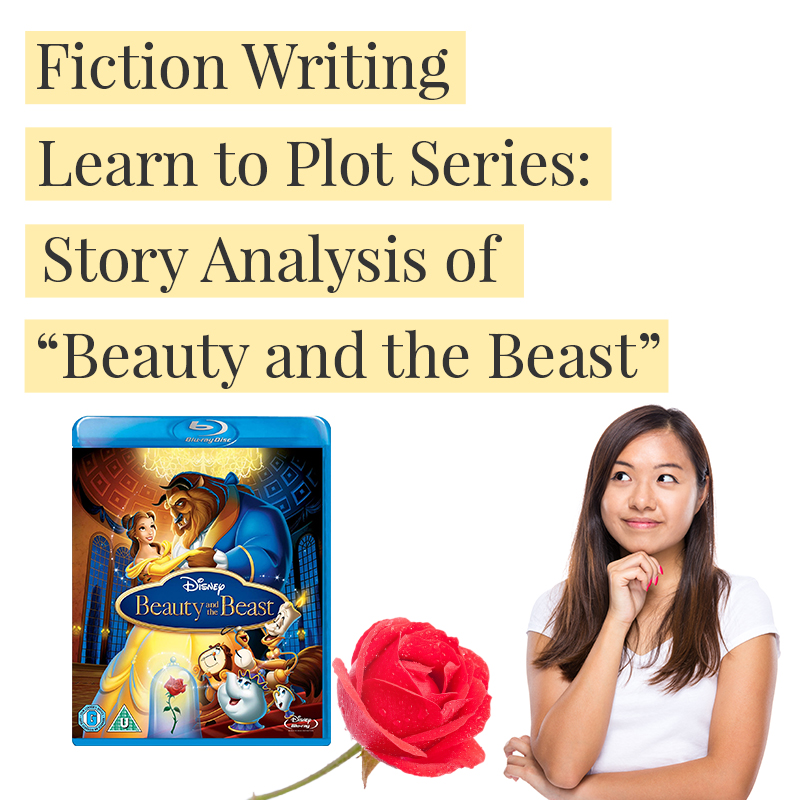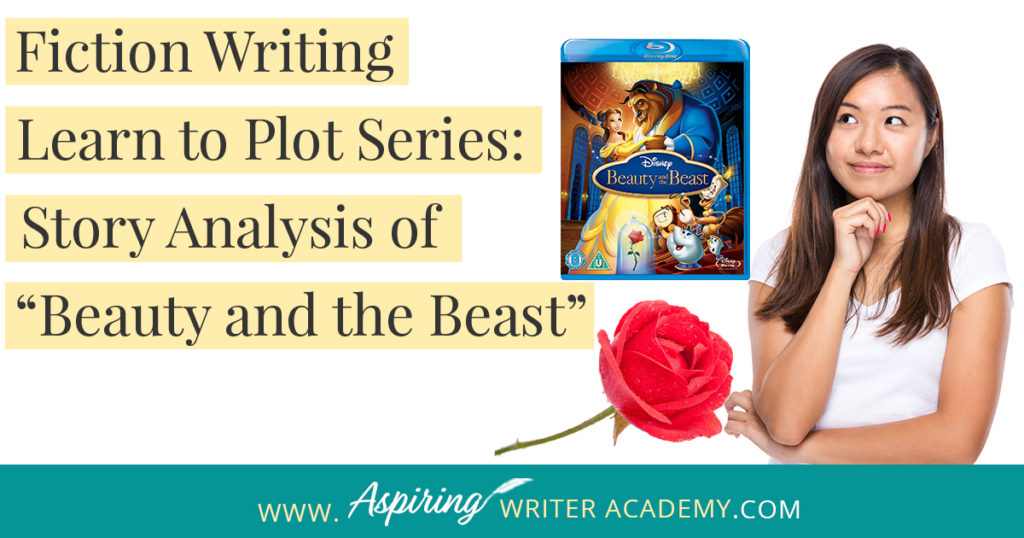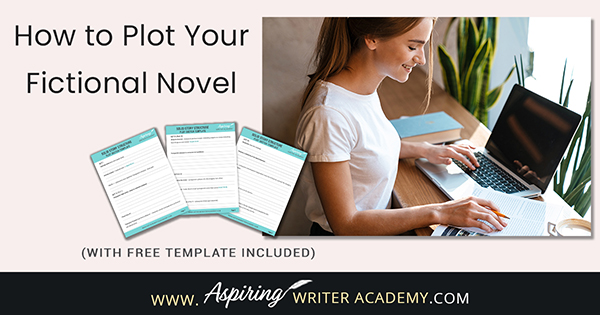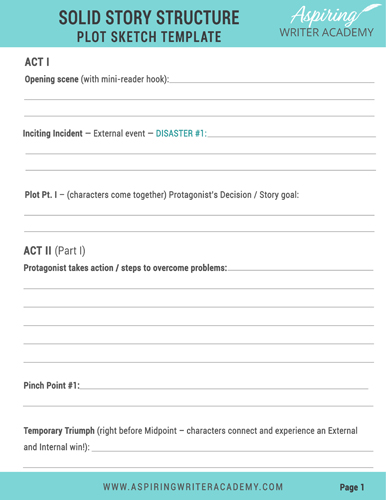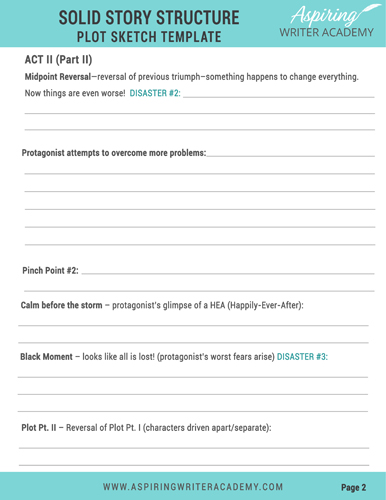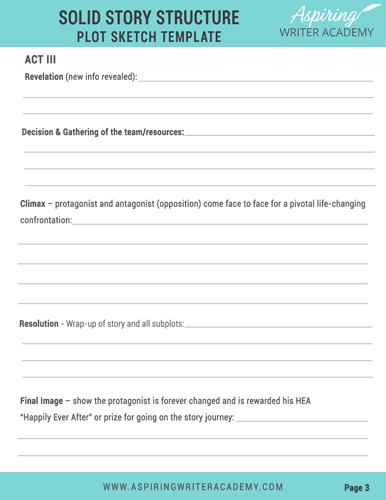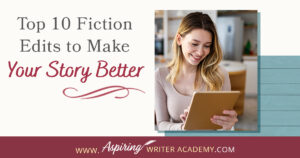Learn to Plot Fiction Writing Series: Story Analysis of “Beauty and the Beast”
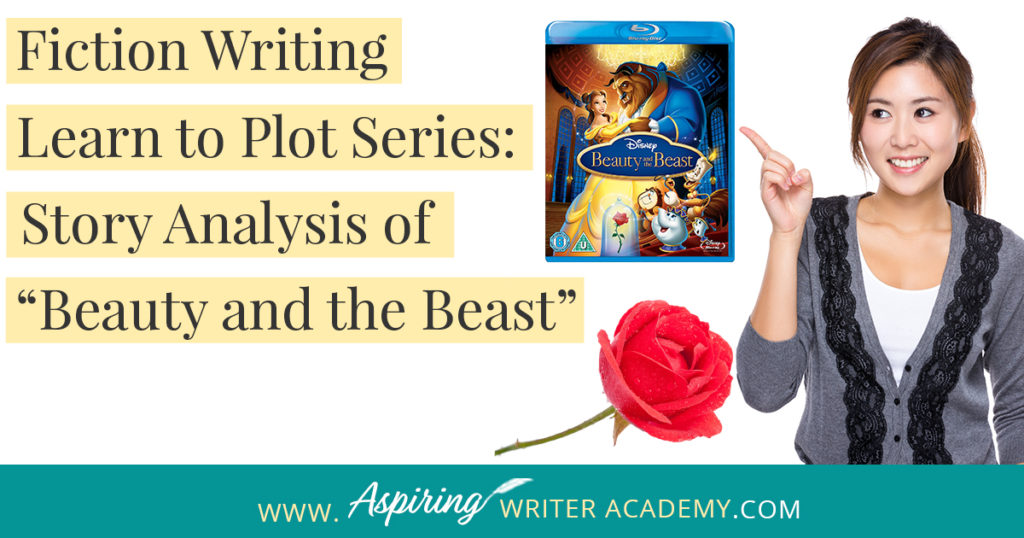
Many writers believe they can just sit down and write whatever pops into their head. However, most Popular Fiction contains specific components or “Plot Points” that serve to move a story forward from beginning to end.
In our Learn to Plot Fiction Writing Series: Story Analysis of Disney's “Beauty and the Beast” we will show you how to recognize each element and provide you with a Free Plot Template so you can draft satisfying, high-quality stories of your own.
ACT I
Opening Scenes:
What do the opening scenes of “Beauty and the Beast” accomplish? How do they serve to set up the story?
- The first few scenes introduce the main characters and their personalities. The selfish, unkind, prideful prince, living in his large castle, rejects an old beggar woman who offers him a single rose in return for shelter from the cold. The woman, (a powerful enchantress in disguise) places a curse on the prince and turns him into a beast until he can learn to love another and earn her love in return. The servants of the castle are also placed under the enchantment and are turned into household objects until the beast can break the curse. Their fate now rests on the beast, their lives will never be the same unless they can help him break the curse. This creates urgency for all involved.
- The theme of the story is introduced when the enchantress warns, “Don’t be deceived by appearances, for beauty is found within.” This sets up the lesson that the prince must learn by the story’s end. The journey (the main body of the story) will hopefully help the prince learn this lesson. This theme is also tied to a tangible object that will reappear later and play a crucial role in the story when the enchantress gives the beast an enchanted mirror as his only window to view the outside world. The mirror, a universal symbol for checking one’s external beauty, reminds the beast of his horrid appearance and loveless heart within.
- The stakes are raised even higher (along with the story tension) when the enchantress leaves behind the rose which will bloom until the prince’s twenty-first year and informs him that if he does not find love by the time the last petal falls, he will remain a beast forever. This effectively sets up the deadline for him to accomplish this new personal goal with a “ticking clock.”
- Special Note:
Now many people who are familiar with the elements of story structure would mistake this opening for the Inciting Incident, the devastating event that turns everything upside down. And for the young prince, it is.
However, most of the story is told from Belle’s point of view and the current story does not really begin until the beauty and the beast meet. The scene when the beast is cursed for his behavior happens in the past. Several years pass before the current story begins.
So, this ‘opening scene’ is relevant back story, a prologue, that sets up the information needed for the current story to begin. This opening also captures the reader’s interest with an intriguing “hook.” The prince is sorry for what he’s done (capturing the heart of the reader) but it is too late. There is now only one way to break the curse, and this makes the reader want to keep reading to see what happens.
If you are not familiar with the elements of Solid Story Structure for Popular Fiction, you may want to see our post, How to Plot Your Fictional Novel, to help you further understand the specifics of what should be included in each section.
Next, we jump to the present, and we see the opening scenes for the current story. In many Popular Fiction stories, the first opening scenes would start here with the backstory only revealed in small bits as needed.
- The current story opens with the main character (protagonist). Belle, “different from the rest,” is a quirky girl who loves reading books. Her strength is her passion for stories and longing for travel and new adventures. Her sympathetic “opening problem” or weakness, which connects her with the hearts of the audience, is that she doesn’t quite fit in with the others in her small village. Feeling alone and wanting to fit in is a unifying universal longing that many people can relate to.
- The antagonist (opposition) in the story is Gaston, a skilled trophy hunter (strength), who has quite an ego, which is his weakness. His personal goal is to marry Belle.
- In the opening scenes, we see Belle loves her father (another admirable trait) and is not interested in marrying Gaston. Relationships between all the major players are established as well as their personal goals. Belle dreams of a better life in the big world. Gaston wants a trophy wife.
- The time period, and setting—France—is also established, as well as the genre. While the main genre is romance, the story also includes sub-genre revealing scenes which tell the audience this is also a historical, fantasy (fairytale), and a fun tale intended for children. The rules of the story world are established: this is a world where magical curses and enchanted objects exist.
Inciting Incident:
After the opening scenes have introduced the characters and have set up the time period, location, genre, hinted theme, and general pacing of the story, the protagonist is hit with the inciting incident, which rocks her ‘ordinary world’ and turns her life upside down.
The protagonist must now decide how to deal with this serious problem, which becomes her new focus for the remainder of the story. The action plan to overcome this serious problem becomes the protagonist’s story-worthy goal.
(The inciting incident is also referred to as the first major turning point to turn the story in a different direction or Disaster #1.)
In “Beauty and the Beast,” the inciting incident is when the beast locks Belle’s father in the castle tower and to save him, Belle decides she must sacrifice her own freedom and ask to take her father’s place.
Plot Point I:
Plot Point I is the agreement between characters, the place where characters come together. The beast agrees to let Belle take her father’s place. He releases her father and locks Belle up instead.
Download our Free Solid Story Structure Plot Sketch Template to help you analyze books or movies, and plot stories of your very own:
ACT II (Part I)
Now we journey into the main body of the story. In the first half of ACT II Belle is released from the tower, given a room, and gains permission to explore her ‘new home.’ Except for the West Wing, a section of the castle she is forbidden to enter, which only creates more intrigue.
Belle is in reaction mode to her new surroundings, getting to know the other characters and different rooms of the castle, along with the fact that this is no ordinary castle—but a place that is enchanted.
She struggles to overcome the problems that arise with living in this castle with the beast. Their relationship is tested as they learn to relate to each other.
Intrigued by a slashed photo of the young prince and the warning never to go into the West Wing, Belle angers the beast when she disobeys and discovers the fatal blooming rose. He yells at her to get out and she runs away only to be cornered by wolves.
Pinch Point #1:
Belle’s life is in danger, but the beast saves her, although he is badly wounded. Belle can run off to freedom but remembers her promise to stay and take her father’s place.
It appears Belle and the Beast have been battling against each other, but after the beast saves her and she does not leave but instead decides to stay and bandage his wound, a new understanding develops between them. Belle realizes the beast can be sweet and they become friends.
The staff at the castle thinks Belle could be the one to help the beast break the curse and urge him to do something nice for Belle. The beast shows her the library filled with books. She teaches the beast to be gentle with the birds in the yard and how to smile again as she and the beast have a snowball fight.
Temporary Triumph:
The beast invites Belle to a formal dinner, and afterward they dance, and it looks like they are falling in love. Belle realizes she can be happy living at the castle with the beast. The castle staff is excited and expect the curse will be lifted very soon!
ACT II (Part 2)
Midpoint Reversal:
Bam! Just when everything seems fine and the goal within reach, an event happens at Midpoint, the second major plot point, to turn the story in a different direction again. Disaster #2 changes everything and reverses the temporary triumph.
When the beast gives Belle the enchanted mirror to see her father, she is shocked to see her father is sick. The beast, who now cares for Belle realizes he must let her go so she may help her father. He gives her the mirror, so she has a way to look back on the beast and remember him. Now the castle staff do not believe the curse will ever be broken! And they were so close!
During the second half of ACT II, the protagonist must struggle to overcome a new set of problems.
Pinch Point #2:
Gaston convinces the town that Belle’s father is crazy for raving about a beast and wants the director of the asylum to take her father away and lock him up. Unless Belle agrees to marry Gaston. The first and second pinch points tug at, twist, or “pinch” the heart with emotion and remind the protagonist the reason they need to remain focused on achieving their goal. Belle is concerned for the welfare of her father.
The Calm Before the Storm:
Belle shows Gaston and the villagers the mirror to prove her father is not crazy. She believes this should solve everything and they can all live happily-ever-after.
The Black Moment:
Belle’s action saves her father but places the beast, whom she has also come to love, in grave danger. For now, Gaston is furious his plan to force Belle to marry him has failed and he incites the villagers to go kill the beast! In a back-and-forth tug of war of wills, Belle tries to stop Gaston, but he has her and her father locked in the cellar while the villagers gather weapons and torches to storm the castle. Belle feels guilt that this is all her fault.
Gaston steals the mirror and leads the way to the castle. The castle staff is in distress as they prepare for battle. Without Belle, the beast does not have the will to fight, and it looks like all is lost. It is the dark night of the soul, the bleakest moment, which is also the third major turning point, Disaster #3.
Plot Point II:
The opposite of Plot Point I. The events of the Black Moment usually cause the characters to separate, and the protagonist finds himself alone. Belle is locked in the cellar with her father, but she is trapped, stuck, unable to help the beast or do anything about her current situation.
ACT III
Revelation:
Then, suddenly the protagonist gets a new piece of information, a breakthrough that allows the protagonist to believe that with one last try, she might just be able to stop the antagonist!
Belle discovers her friend Chip, the son of Mrs. Potts, who hid himself away in Belle’s saddlebag when she left the castle, is now here to open the cellar door and allow Belle and her father to escape.
Decision:
Belle can now run to the castle to stop the fighting and save the beast!
Re-gathering of the Team or Resources:
Belle and Chip re-mount her horse, Philippe, and race to reconnect with the castle staff and help protect the beast against Gaston and the villagers.
Climax:
This is the most exciting scene in the entire book or movie. This is a face-to-face confrontation between the protagonist and the opposition. Either the protagonist succeeds once and for all or he fails. Everything is put on the line.
The beast has no desire to fight Gaston and is pushed onto the edge of the upper balcony. He rouses when he hears Belle’s voice and gains the upper hand on Gaston, who pleads for his life. Belle joins them and tries to stop the battle. Because of Belle’s influence during the story, the beast realizes he has changed and no longer has the desire to kill. He releases Gaston, who then pulls out a knife and stabs the beast in the back. Terrified by the beast’s growl, Gaston steps backward, his foot gets caught on the rain gutter, and he falls off the balcony to his death. They have defeated him!
Resolution:
The beast is hurt, and the last rose petal is about to fall, after which he will remain a beast forever. But when Belle tells him she loves him the spell is broken, and miraculous things start to happen. The beast is transformed back into a human, the sub-plots are wrapped up as the castle staff returns to their original form.
Final Image:
Because the beast acted heroically and learned his lesson, and because this is a magical story after all, the curse is broken, love heals, and the beast receives his reward and returns to human form. Belle, who has also learned that appearances can be deceiving and has come to love the beast also receives her reward when the beast is transformed into a handsome prince! The other lives hanging in the balance are also transformed. Belle and the prince hug and dance and the audience is promised they will all live happily-ever-after.
Additional Thoughts:
How does this story structure line up with your own writing? Have you included all the steps or are you missing some?
I hope that you have enjoyed our Learn to Plot Fiction Writing Series: Story Analysis of Disney's “Beauty and the Beast” and have downloaded the Free Solid Story Structure Plot Template to analyze more books and movies, or perhaps to outline a story of your own.
If you like more help outlining your story, you may wish to download our Free Brainstorming Your Story Idea Worksheet
Do you find it difficult to create compelling antagonists and villains for your stories? Do your villains feel cartoonish and unbelievable? Do they lack motivation or a specific game plan? Discover the secrets to crafting villains that will stick with your readers long after they finish your story, with our How to Create Antagonists & Villains Workbook.
This 32-page instructional workbook is packed with valuable fill-in-the-blank templates and practical advice to help you create memorable and effective antagonists and villains. Whether you're a seasoned writer or just starting out, this workbook will take your writing to the next level.
If you have any questions or would like to leave a comment below, we would love to hear from you!
Our Goal for Aspiring Writer Academy is to help people learn how to write quality fiction, teach them to publish and promote their work, and to give them the necessary tools to pursue a writing career.

ENTER YOUR EMAIL BELOW
TO GET YOUR FREE
"Brainstorming Your Story Idea Worksheet"
7 easy fill-in-the-blank pages,
+ 2 bonus pages filled with additional story examples.
A valuable tool to develop story plots again and again.
Other Blog Posts You May Like
How to Plot Your Fictional Novel (with Free Template Included)
The Ultimate Book Signing Checklist: What to Bring to Your First Book Signing
5 Questions to Create Believable Villains
Why Your Characters Need Story-Worthy Goals
3 Levels of Goal Setting for Fiction Writers
Fiction Writing: How to Write a Back Cover Blurb that Sells
Fiction Writing: How to Name Your Cast of Characters
How to Captivate Your Readers with Scene-Ending Hooks
Scene & Sequel: The Secret to Plotting an Epic Novel
Scene & Sequel: The Secret to Plotting an Epic Novel (Part 2)
Writing Fiction: How to Develop Your Story Premise
12 Quick Tips to Write Dazzling Dialogue
10 Questions to Ask When Creating Characters for Your Story
Macro Edits: Looking at Your Story as a Whole
Basic Story Structure: How to Plot in 6 Steps

is a multi-published author, speaker, and writing coach. She writes sweet contemporary, inspirational, and historical romance and loves teaching aspiring writers how to write quality fiction. Read her inspiring story of how she published her first book and launched a successful writing career.

